Organic electroluminescent materials and devices
Margulies , et al.
U.S. patent number 10,672,997 [Application Number 15/619,217] was granted by the patent office on 2020-06-02 for organic electroluminescent materials and devices. This patent grant is currently assigned to UNIVERSAL DISPLAY CORPORATION. The grantee listed for this patent is Universal Display Corporation. Invention is credited to Julia J. Brown, Alan Deangelis, Alexey Borisovich Dyatkin, Zhiqiang Ji, Chun Lin, Bin Ma, Eric A. Margulies, Mingjuan Su, Jui-Yi Tsai, Michael S. Weaver, Chuanjun Xia, Walter Yeager, Lichang Zeng.
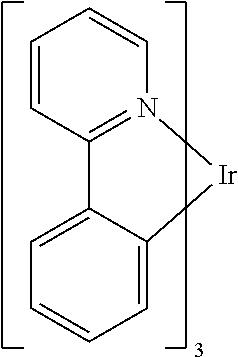




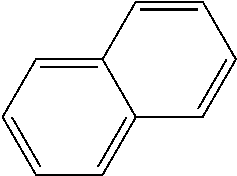






View All Diagrams
| United States Patent | 10,672,997 |
| Margulies , et al. | June 2, 2020 |
Organic electroluminescent materials and devices
Abstract
A compound is disclosed that has a metal coordination complex structure having at least two ligands coordinated to the metal; wherein the compound has a first substituent R.sup.1 at one of the ligands' periphery; wherein a first distance is defined as the distance between the metal and one of the atoms in R.sup.1 where that atom is the farthest away from the metal among the atoms in R.sup.1; wherein the first distance is also longer than any other atom-to-metal distance between the metal and any other atoms in the compound; and wherein when a sphere having a radius r is defined whose center is at the metal and the radius r is the smallest radius that will allow the sphere to enclose all atoms in the compound that are not part of R.sup.1, the first distance is longer than the radius r by at least 2.9 .ANG..
| Inventors: | Margulies; Eric A. (Ewing, NJ), Ji; Zhiqiang (Hillsborough, NJ), Tsai; Jui-Yi (Newtown, PA), Lin; Chun (Yardley, PA), Dyatkin; Alexey Borisovich (Ambler, PA), Su; Mingjuan (Ewing, NJ), Ma; Bin (Plainsboro, NJ), Weaver; Michael S. (Princeton, NJ), Brown; Julia J. (Yardley, PA), Zeng; Lichang (Lawrenceville, NJ), Yeager; Walter (Yardley, PA), Deangelis; Alan (Pennington, NJ), Xia; Chuanjun (Lawrenceville, NJ) | ||||||||||
|---|---|---|---|---|---|---|---|---|---|---|---|
| Applicant: |
|
||||||||||
| Assignee: | UNIVERSAL DISPLAY CORPORATION
(Ewing, NJ) |
||||||||||
| Family ID: | 59093411 | ||||||||||
| Appl. No.: | 15/619,217 | ||||||||||
| Filed: | June 9, 2017 |
Prior Publication Data
| Document Identifier | Publication Date | |
|---|---|---|
| US 20170365801 A1 | Dec 21, 2017 | |
Related U.S. Patent Documents
| Application Number | Filing Date | Patent Number | Issue Date | ||
|---|---|---|---|---|---|
| 62516329 | Jun 7, 2017 | ||||
| 62352119 | Jun 20, 2016 | ||||
| 62352139 | Jun 20, 2016 | ||||
| 62450848 | Jan 26, 2017 | ||||
| 62479795 | Mar 31, 2017 | ||||
| 62480746 | Apr 3, 2017 | ||||
| Current U.S. Class: | 1/1 |
| Current CPC Class: | C09K 11/06 (20130101); C07F 15/0033 (20130101); H01L 51/0085 (20130101); C09K 2211/1044 (20130101); H01L 51/5221 (20130101); C09K 2211/1022 (20130101); C09K 2211/1011 (20130101); C09K 2211/1088 (20130101); H01L 51/5206 (20130101); C09K 2211/1029 (20130101); C09K 2211/1033 (20130101); H01L 51/5016 (20130101); C09K 2211/1092 (20130101); C09K 2211/1007 (20130101); C09K 2211/185 (20130101) |
| Current International Class: | H01L 51/00 (20060101); C09K 11/06 (20060101); C07F 15/00 (20060101); H01L 51/52 (20060101); H01L 51/50 (20060101) |
References Cited [Referenced By]
U.S. Patent Documents
| 4769292 | September 1988 | Tang et al. |
| 5061569 | October 1991 | VanSlyke et al. |
| 5247190 | September 1993 | Friend et al. |
| 5703436 | December 1997 | Forrest et al. |
| 5707745 | January 1998 | Forrest et al. |
| 5834893 | November 1998 | Bulovic et al. |
| 5844363 | December 1998 | Gu et al. |
| 6013982 | January 2000 | Thompson et al. |
| 6087196 | July 2000 | Sturm et al. |
| 6091195 | July 2000 | Forrest et al. |
| 6097147 | August 2000 | Baldo et al. |
| 6294398 | September 2001 | Kim et al. |
| 6303238 | October 2001 | Thompson et al. |
| 6337102 | January 2002 | Forrest et al. |
| 6468819 | October 2002 | Kim et al. |
| 6528187 | March 2003 | Okada |
| 6687266 | February 2004 | Ma et al. |
| 6835469 | December 2004 | Kwong et al. |
| 6921915 | July 2005 | Takiguchi et al. |
| 7087321 | August 2006 | Kwong et al. |
| 7090928 | August 2006 | Thompson et al. |
| 7154114 | December 2006 | Brooks et al. |
| 7250226 | July 2007 | Tokito et al. |
| 7279704 | October 2007 | Walters et al. |
| 7332232 | February 2008 | Ma et al. |
| 7338722 | March 2008 | Thompson et al. |
| 7393599 | July 2008 | Thompson et al. |
| 7396598 | July 2008 | Takeuchi et al. |
| 7431968 | October 2008 | Shtein et al. |
| 7442797 | October 2008 | Itoh |
| 7445855 | November 2008 | Mackenzie et al. |
| 7534505 | May 2009 | Lin et al. |
| 7732606 | June 2010 | Ise |
| 9673409 | June 2017 | Li |
| 10243154 | March 2019 | Che |
| 2002/0034656 | March 2002 | Thompson et al. |
| 2002/0134984 | September 2002 | Igarashi |
| 2002/0158242 | October 2002 | Son et al. |
| 2003/0138657 | July 2003 | Li et al. |
| 2003/0152802 | August 2003 | Tsuboyama et al. |
| 2003/0162053 | August 2003 | Marks et al. |
| 2003/0175553 | September 2003 | Thompson et al. |
| 2003/0230980 | December 2003 | Forrest et al. |
| 2004/0036077 | February 2004 | Ise |
| 2004/0137267 | July 2004 | Igarashi et al. |
| 2004/0137268 | July 2004 | Igarashi et al. |
| 2004/0174116 | September 2004 | Lu et al. |
| 2005/0025993 | February 2005 | Thompson et al. |
| 2005/0112407 | May 2005 | Ogasawara et al. |
| 2005/0238919 | October 2005 | Ogasawara |
| 2005/0244673 | November 2005 | Satoh et al. |
| 2005/0260441 | November 2005 | Thompson et al. |
| 2005/0260449 | November 2005 | Walters et al. |
| 2006/0008670 | January 2006 | Lin et al. |
| 2006/0182992 | August 2006 | Nii |
| 2006/0202194 | September 2006 | Jeong et al. |
| 2006/0240279 | October 2006 | Adamovich et al. |
| 2006/0251923 | November 2006 | Lin et al. |
| 2006/0263635 | November 2006 | Ise |
| 2006/0280965 | December 2006 | Kwong et al. |
| 2007/0190359 | August 2007 | Knowles et al. |
| 2007/0278936 | December 2007 | Herron |
| 2007/0278938 | December 2007 | Yabunouchi et al. |
| 2008/0015355 | January 2008 | Schafer et al. |
| 2008/0018221 | January 2008 | Egen et al. |
| 2008/0106190 | May 2008 | Yabunouchi et al. |
| 2008/0124572 | May 2008 | Mizuki et al. |
| 2008/0220265 | September 2008 | Xia et al. |
| 2008/0297033 | December 2008 | Knowles et al. |
| 2009/0008605 | January 2009 | Kawamura et al. |
| 2009/0009065 | January 2009 | Nishimura et al. |
| 2009/0017330 | January 2009 | Iwakuma et al. |
| 2009/0030202 | January 2009 | Iwakuma et al. |
| 2009/0039776 | February 2009 | Yamada et al. |
| 2009/0045730 | February 2009 | Nishimura et al. |
| 2009/0045731 | February 2009 | Nishimura et al. |
| 2009/0101870 | April 2009 | Pakash et al. |
| 2009/0108737 | April 2009 | Kwong et al. |
| 2009/0115316 | May 2009 | Zheng et al. |
| 2009/0124805 | May 2009 | Alleyne |
| 2009/0165846 | July 2009 | Johannes et al. |
| 2009/0167162 | July 2009 | Lin et al. |
| 2009/0179554 | July 2009 | Kuma et al. |
| 2011/0049496 | March 2011 | Fukuzaki |
| 2013/0082248 | April 2013 | Groarke |
| 2013/0328018 | December 2013 | Xia et al. |
| 2013/0328019 | December 2013 | Xia et al. |
| 2014/0021449 | January 2014 | Xia |
| 2014/0197386 | July 2014 | Kim et al. |
| 2014/0306206 | October 2014 | Watanabe et al. |
| 2014/0378685 | December 2014 | Catinat |
| 2015/0011764 | January 2015 | Catinat |
| 2015/0060830 | March 2015 | Thompson |
| 2015/0069334 | March 2015 | Xia et al. |
| 2015/0207086 | July 2015 | Li |
| 2015/0357586 | December 2015 | Horiuchi |
| 2015/0357587 | December 2015 | Kishino |
| 2015/0364701 | December 2015 | Horiuchi |
| 2016/0111661 | April 2016 | Boudreault |
| 2016/0118604 | April 2016 | Choi |
| 2017/0229663 | August 2017 | Tsai |
| 2017/0365799 | December 2017 | Ji |
| 2017/0365800 | December 2017 | Tsai |
| 2017/0373259 | December 2017 | Su |
| 2018/0134954 | May 2018 | Tsai |
| 0650955 | May 1995 | EP | |||
| 1725079 | Nov 2006 | EP | |||
| 2034538 | Mar 2009 | EP | |||
| 200511610 | Jan 2005 | JP | |||
| 2007123392 | May 2007 | JP | |||
| 2007254297 | Oct 2007 | JP | |||
| 2008074939 | Apr 2008 | JP | |||
| 2010084003 | Apr 2010 | JP | |||
| 2010120893 | Jun 2010 | JP | |||
| 2015173199 | Oct 2015 | JP | |||
| 01/39234 | May 2001 | WO | |||
| 02/02714 | Jan 2002 | WO | |||
| 02015654 | Feb 2002 | WO | |||
| 03040257 | May 2003 | WO | |||
| 03060956 | Jul 2003 | WO | |||
| 2004093207 | Oct 2004 | WO | |||
| 04107822 | Dec 2004 | WO | |||
| 2005014551 | Feb 2005 | WO | |||
| 2005019373 | Mar 2005 | WO | |||
| 2005030900 | Apr 2005 | WO | |||
| 2005089025 | Sep 2005 | WO | |||
| 2005/097942 | Oct 2005 | WO | |||
| 2005123873 | Dec 2005 | WO | |||
| 2006009024 | Jan 2006 | WO | |||
| 2006056418 | Jun 2006 | WO | |||
| 2006072002 | Jul 2006 | WO | |||
| 2006082742 | Aug 2006 | WO | |||
| 2006098120 | Sep 2006 | WO | |||
| 2006100298 | Sep 2006 | WO | |||
| 2006103874 | Oct 2006 | WO | |||
| 2006114966 | Nov 2006 | WO | |||
| 2006132173 | Dec 2006 | WO | |||
| 2007002683 | Jan 2007 | WO | |||
| 2007004380 | Jan 2007 | WO | |||
| 2007063754 | Jun 2007 | WO | |||
| 2007063796 | Jun 2007 | WO | |||
| 2008056746 | May 2008 | WO | |||
| 2008101842 | Aug 2008 | WO | |||
| 2008132085 | Nov 2008 | WO | |||
| 2009000673 | Dec 2008 | WO | |||
| 2009003898 | Jan 2009 | WO | |||
| 2009008311 | Jan 2009 | WO | |||
| 2009018009 | Feb 2009 | WO | |||
| 2009021126 | Feb 2009 | WO | |||
| 2009050290 | Apr 2009 | WO | |||
| 2009062578 | May 2009 | WO | |||
| 2009063833 | May 2009 | WO | |||
| 2009066778 | May 2009 | WO | |||
| 2009066779 | May 2009 | WO | |||
| 2009086028 | Jul 2009 | WO | |||
| 2009100991 | Aug 2009 | WO | |||
| 2014/033050 | Mar 2014 | WO | |||
| 2014/112450 | Jul 2014 | WO | |||
| 2014/112657 | Jul 2014 | WO | |||
Other References
|
Burke et al. "An efficient route to asymmetrically diconjugated tris(heteroleptic) complexes of Ru(II)" RSC Adv. 2016, 6, 40869-40877. (Year: 2016). cited by examiner . Williams et al. "Light-emitting iridium complexes with tridentate ligands" Dalton Trans., 2008, 2081-2099. (Year: 2008). cited by examiner . Fleetham et al. "Efficient "Pure" Blue OLEDs Employing Tetradentate Pt Complexes with a Narrow Spectral Bandwidth" Adv. Mater. 2014, 26, 7116-7121. (Year: 2014). cited by examiner . Stinner et al. "Synthesis and Spectroelectrochemistry of Ir(bpy)(phen)(phi)3+, a Tris(heteroleptic Metallointercalator" Inorg. Chem. 2001, 40, 5245-5250. (Year: 2001). cited by examiner . Machine translation of JP-2010084003, translation generated Oct. 2019, 29 pages. (Year: 2019). cited by examiner . Kim, Kwon-Hyeon et al., "Highly Efficient Organic Light-Emitting Diodes with Phosphorescent Emitters Having High Quantum Yield and Horizontal Orientation of Transition Dipole Moments", Adv. Mater. 2014, 26, pp. 3844-3847. cited by applicant . Kim, Kwon-Hyeon et al., "Design of Heteroleptic Ir Complexes with Horizontal Emitting Dipoles for Highly Efficient Organic Light-Emitting Diodes with an External Quantum Efficiency of 38%", Chem. Mater. 2016, 28, pp. 7505-7510. cited by applicant . Graf, A. et al., "Correlating the transition dipole moment orientation of phosphorescent emitter molecules OLEDs with basic material properties", J. Mater. Chem. C, 2014, 2, pp. 10298-10304. cited by applicant . Jurow, Matthew J. et al, "Understanding and predicting the orientation of heteroleptic phosphors in organic light-emitting materials", Nature Materials, vol. 15, Jan. 2016, pp. 85-91. cited by applicant . Kim, Kwon-Hyeon et al., "Phosphorescent dye-based supramolecules for high-efficiency organic light-emitting diodes", Nature Communications, 5:4769, Sep. 2014, pp. 1-8. cited by applicant . Plummer, Edward A. et al., "Electrophosphorescent Devices Based on Cationic Complexes: Control of Switch-on Voltage and Efficiency Through Modification of Charge Injection and Charge Transport", Adv. Funct. Mater. 2005, vol. 15, No. 2, Feb. 2005, pp. 281-289. cited by applicant . Edkins, Robert M. "The synthesis and photophysics of tris-heteroleptic cyclometalated iridium complexes", Dalton Transactions, vol. 40, No. 38, Oct. 2011, pp. 9672-9678. cited by applicant . European Search Report dated Oct. 26, 2017 for corresponding European Patent Application No. 17176695.9. cited by applicant . Adachi, Chihaya et al., "Organic Electroluminescent Device Having a Hole Conductor as an Emitting Layer," Appl. Phys. Lett., 55(15): 1489-1491 (1989). cited by applicant . Adachi, Chihaya et al., "Nearly 100% Internal Phosphorescence Efficiency in an Organic Light Emitting Device," J. Appl. Phys., 90(10): 5048-5051 (2001). cited by applicant . Adachi, Chihaya et al., "High-Efficiency Red Electrophosphorescence Devices," Appl. Phys. Lett., 78(11)1622-1624 (2001). cited by applicant . Aonuma, Masaki et al., "Material Design of Hole Transport Materials Capable of Thick-Film Formation in Organic Light Emitting Diodes," Appl. Phys. Lett., 90, Apr. 30, 2007, 183503-1-183503-3. cited by applicant . Baldo et al., Highly Efficient Phosphorescent Emission from Organic Electroluminescent Devices, Nature, vol. 395, 151-154, (1998). cited by applicant . Baldo et al., Very high-efficiency green organic light-emitting devices based on electrophosphorescence, Appl. Phys. Lett., vol. 75, No. 1, 4-6 (1999). cited by applicant . Gao, Zhigiang et al., "Bright-Blue Electroluminescence From a Silyl-Substituted ter-(phenylene-vinylene) derivative," Appl. Phys. Lett., 74(6): 865-867 (1999). cited by applicant . Guo, Tzung-Fang et al., "Highly Efficient Electrophosphorescent Polymer Light-Emitting Devices," Organic Electronics, 1: 15-20 (2000). cited by applicant . Hamada, Yuji et al., "High Luminance in Organic Electroluminescent Devices with Bis(10-hydroxybenzo[h]quinolinato) beryllium as an Emitter, " Chem. Lett., 905-906 (1993). cited by applicant . Holmes, R.J. et al., "Blue Organic Electrophosphorescence Using Exothermic Host-Guest Energy Transfer," Appl. Phys. Lett., 82(15):2422-2424 (2003). cited by applicant . Hu, Nan-Xing et al., "Novel High Tg Hole-Transport Molecules Based on Indolo[3,2-b]carbazoles for Organic Light-Emitting Devices," Synthetic Metals, 111-112:421-424 (2000). cited by applicant . Huang, Jinsong et al., "Highly Efficient Red-Emission Polymer Phosphorescent Light-Emitting Diodes Based on Two Novel Tris(1-phenylisoquinolinato-C2,N)iridium(III) Derivatives," Adv. Mater, 19:739-743 (2007). cited by applicant . Huang, Wei-Sheng et al., "Highly Phosphorescent Bis-Cyclometalated Iridium Complexes Containing Benzoimidazole-Based Ligands," Chem. Mater., 16(12):2480-2488 (2004). cited by applicant . Hung, L.S. et al., "Anode Modification in Organic Light-Emitting Diodes by Low-Frequency Plasma Polymerization of CHF3," Appl. Phys. Lett., 78(5):673-675 (2001). cited by applicant . Ikai, Masamichi et al., "Highly Efficient Phosphorescence From Organic Light-Emitting Devices with an Exciton-Block Layer," Appl. Phys. Lett., 79(2):156-158 (2001). cited by applicant . Ikeda, Hisao et al., "P-185 Low-Drive-Voltage OLEDs with a Buffer Layer Having Molybdenum Oxide," SID Symposium Digest, 37:923-926 (2006). cited by applicant . Inada, Hiroshi and Shirota, Yasuhiko, "1,3,5-Tris[4-(diphenylamino)phenyl]benzene and its Methylsubstituted Derivatives as a Novel Class of Amorphous Molecular Materials," J. Mater Chem., 3(3):319-320 (1993). cited by applicant . Kanno, Hiroshi et al., "Highly Efficient and Stable Red Phosphorescent Organic Light-Emitting Device Using bis[2-(2-benzothiazoyl)phenolato]zinc(II) as host material," Appl. Phys. Lett., 90:123509-1-123509-3 (2007). cited by applicant . Kido, Junji et al., 1,2,4-Triazole Derivative as an Electron Transport Layer in Organic Electroluminescent Devices, Jpn. J. Appl. Phys., 32:L917-L920 (1993). cited by applicant . Kuwabara, Yoshiyuki et al., "Thermally Stable Multilayered Organic Electroluminescent Devices Using Novel Starburst Molecules, 4,4',4''-Tri(N-carbazolyl)triphenylamine (TCTA) and 4,4',4''-Tris(3-methylphenylphenyl-amino)triphenylamine (m-MTDATA), as Hole-Transport Materials," Adv. Mater, 6(9):677-679 (1994). cited by applicant . Kwong, Raymond C. et al., "High Operational Stability of Electrophosphorescent Devices," Appl. Phys. Lett., 81(1)162-164 (2002). cited by applicant . Lamansky, Sergey et al., "Synthesis and Characterization of Phosphorescent Cyclometalated Iridium Complexes," Inorg. Chem., 40(7):1704-1711 (2001). cited by applicant . Lee, Chang-Lyoul et al., "Polymer Phosphorescent Light-Emitting Devices Doped with Tris(2-phenylpyridine) Iridium as a Triplet Emitter," Appl. Phys. Lett., 77(15):2280-2282 (2000). cited by applicant . Lo, Shih-Chun et al., "Blue Phosphorescence from Iridium(III) Complexes at Room Temperature," Chem. Mater., 18(21)5119-5129 (2006). cited by applicant . Ma, Yuguang et al., "Triplet Luminescent Dinuclear-Gold(I) Complex-Based Light-Emitting Diodes with Low Turn-On voltage," Appl. Phys. Lett., 74(10):1361-1363 (1999). cited by applicant . Mi, Bao-Xiu et al., "Thermally Stable Hole-Transporting Material for Organic Light-Emitting Diode an Isoindole Derivative," Chem. Mater., 15(16):3148-3151 (2003). cited by applicant . Nishida, Jun-ichi et al., "Preparation, Characterization, and Electroluminescence Characteristics of .alpha.-Diimine-type Platinum(II) Complexes with Perfluorinated Phenyl Groups as Ligands," Chem. Lett., 34(4): 592-593 (2005). cited by applicant . Niu, Yu-Hua et al., "Highly Efficient Electrophosphorescent Devices with Saturated Red Emission from a Neutral Osmium Complex," Chem. Mater., 17(13):3532-3536 (2005). cited by applicant . Noda, Tetsuya and Shirota,Yasuhiko, "5,5'-Bis(dimesitylbory1)-2,2'-bithiophene and 5,5''-Bis(dimesitylbory1)-2,2'5',2''-terthiophene as a Novel Family of Electron-Transporting Amorphous Molecular Materials," J. Am. Chem. Soc., 120 (37):9714-9715 (1998). cited by applicant . Okumoto, Kenji et al., "Green Fluorescent Organic Light-Emitting Device with External Quantum Efficiency of Nearly 10%," Appl. Phys. Lett., 89:063504-1-063504-3 (2006). cited by applicant . Palilis, Leonidas C., "High Efficiency Molecular Organic Light-Emitting Diodes Based on Silole Derivatives and Their Exciplexes," Organic Electronics, 4:113-121 (2003). cited by applicant . Paulose, Betty Marie Jennifer S. et al., "First Examples of Alkenyl Pyridines as Organic Ligands for Phosphorescent Iridium Complexes," Adv. Mater., 16(22):2003-2007 (2004). cited by applicant . Ranjan, Sudhir et al., "Realizing Green Phosphorescent Light-Emitting Materials from Rhenium(I) Pyrazolato Diimine Complexes," Inorg. Chem., 42(4):1248-1255 (2003). cited by applicant . Sakamoto, Youichi et al., "Synthesis, Characterization, and Electron-Transport Property of Perfluorinated Phenylene Dendrimers," J. Am. Chem. Soc., 122(8):1832-1833 (2000). cited by applicant . Salbeck, J. et al., "Low Molecular Organic Glasses for Blue Electroluminescence," Synthetic Metals, 91: 209-215 (1997). cited by applicant . Shirota, Yasuhiko et al., "Starburst Molecules Based on pi-Electron Systems as Materials for Organic Electroluminescent Devices," Journal of Luminescence, 72-74:985-991 (1997). cited by applicant . Sotoyama, Wataru et al., "Efficient Organic Light-Emitting Diodes with Phosphorescent Platinum Complexes Containing N.sup. c.sup. n-Coordinating Tridentate Ligand," Appl. Phys. Lett., 86:153505-1-153505-3 (2005). cited by applicant . Sun, Yiru and Forrest, Stephen R., "High-Efficiency White Organic Light Emitting Devices with Three Separate Phosphorescent Emission Layers," Appl. Phys. Lett., 91:263503-1-263503-3 (2007). cited by applicant . T. Ostergard et al., "Langmuir-Blodgett Light-Emitting Diodes of Poly(3-Hexylthiophene) Electro-Optical Characteristics Related to Structure," Synthetic Metals, 88:171-177 (1997). cited by applicant . Takizawa, Shin-ya et al., "Phosphorescent Iridium Complexes Based on 2-Phenylimidazo[1,2- .alpha.]pyridine Ligands Tuning of Emission Color toward the Blue Region and Application to Polymer Light-Emitting Devices," Inorg. Chem., 46(10):4308-4319 (2007). cited by applicant . Tang, C.W. and VanSlyke, S.A., "Organic Electroluminescent Diodes," Appl. Phys. Lett., 51(12):913-915 (1987). cited by applicant . Tung, Yung-Liang et al., "Organic Light-Emitting Diodes Based on Charge-Neutral Ru II PHosphorescent Emitters," Adv. Mater., 17(8)1059-1064 (2005). cited by applicant . Van Slyke, S. A. et al., "Organic Electroluminescent Devices with Improved Stability," Appl. Phys. Lett., 69(15):2160-2162 (1996). cited by applicant . Wang, Y. et al., "Highly Efficient Electroluminescent Materials Based on Fluorinated Organometallic Iridium Compounds," Appl. Phys. Lett., 79(4):449-451 (2001). cited by applicant . Wong, Keith Man-Chung et al., A Novel Class of Phosphorescent Gold(III) Alkynyl-Based Organic Light-Emitting Devices with Tunable Colour, Chem. Commun., 2906-2908 (2005). cited by applicant . Wong, Wai-Yeung, "Multifunctional Iridium Complexes Based on Carbazole Modules as Highly Efficient Electrophosphors," Angew. Chem. Int. Ed., 45:7800-7803 (2006). cited by applicant . Choi, Gyeongshin et al., "Hemilabile N-Xylyl-N'-methylperimidine Carbene Iridium Complexes as Catalysts for C--H Activation and Dehydrogenative Silylation: Dual Role of N-Xylyl Moiety for ortho-C--H Bond Activation and Reductive Bong Cleavage" J. Am. Chem. Soc. 2013, 135, 13149-13161. cited by applicant . Tordera, Daniel et al., "Stable Green Electroluminescence from an Iridium Tris-Heteroleptic Ionic Complex" Chem. Mater. 2012, 24, 1896-1903. cited by applicant . Baranoff, Etienne et al., "Acid-Induced Degradation of Phosphorescent Dopants for OLEDs and Its Application to the Synthesis of Tris-heteroleptic Iridium(III) Bis-cyclometalated Complexes" Inorg. Chem. 2012, 51, 215-224. cited by applicant . Lepeltier, Marc et al., "Tris-cyclometalated Iridium(III) Complexes with Three Different Ligands: a New Example with 2-(2,4-Difluorophenyl)pyridine-Based Complex" Helvetica Chimica Acta--vol. 97 (2014), 939-956. cited by applicant . Park, Gui Youn et al., "Iridium Complexes Containing Three Different Ligands as White OLED Dopants" Molecular Crystals and Liquid Crystals, vol. 462, pp. 179-188, 2007. cited by applicant . Felici, Marco et al., "Cationic Heteroleptic Cyclometalated Iridium(III) Complexes Containing Phenyl-Triazole and Triazole-Pyridine Clicked Ligands" Molecules 2010, 15, 2039-2059. cited by applicant . Jia-Ling Liao et al.: "Ir(III)-Based Phosphors with Bipyrazolate Ancillaries; Rational Design, Photophysics, and Applications in Organic Light-Emitting Diodes" Inorganic Chemistry, vol. 54, No. 22, Nov. 16, 2015 (Nov. 16, 2015), pp. 10811-10821. cited by applicant . European Search Report dated Oct. 26, 2017 for corresponding EP Application No. 17176668.6. cited by applicant . Burke, Christopher S. and Keyes, Tia E. An Efficient Route to Asymmetrically Diconjugated tris(heteroleptic) Complexes of Ru(II), RSC Advances, vol. 6, Jan. 1, 2013, pp. 40869-40877. cited by applicant . Xu, Xianbin et al., "Trifunctional IRIII ppy-type asymmetric phosphorescent emitters with ambiopolar features for highly efficient electroluminescent devices" Chem. Commun., 2014, 50, pp. 2473-2476. cited by applicant . Xu, Xianbin et al., "tris-Heteroleptic Cyclometalated Iridium(III) Complexes with Ambipolar or Electron Injection/Transport Features for Highly Efficient Electrophosphorescent Devices" Chem. Asian J. 2015, 10, pp. 252-262. cited by applicant . Extended European Search Report dated Apr. 11, 2018 for corresponding EP Application No. 17176681.9. cited by applicant. |
Primary Examiner: Loewe; Robert S
Attorney, Agent or Firm: Duane Morris LLP
Parent Case Text
CROSS-REFERENCE TO RELATED APPLICATIONS
This application claims priority under 35 U.S.C. .sctn. 119(e)(1) from U.S. Provisional Application Ser. No. 62/352,119, filed Jun. 20, 2016, 62/516,329, filed Jun. 7, 2017, 62/352,139, filed Jun. 20, 2016, 62/450,848, filed Jan. 26, 2017, 62/479,795, filed Mar. 31, 2017, and 62/480,746, filed Apr. 3, 2017, the entire contents of which are incorporated herein by reference.
Claims
We claim:
1. A compound having a metal coordination complex structure; wherein the compound is capable of functioning as an emitter in an organic light emitting device at room temperature; wherein when there are more than one ligand in the compound each ligand is different from each other; wherein the compound has the formula of M(L.sup.1)(L.sup.2)(L.sup.3) and L.sup.1, L.sup.2, and L.sup.3 are different from each other; wherein each of L.sup.1, L.sup.2, and L.sup.3 is a ligand having at least two six-membered rings bridged together, wherein two adjacent bridged six-membered rings are each coordinated to the metal, and at least one of the two bridged six-membered rings having at least one nitrogen atom, wherein the compound has a first substituent R.sup.1 at one of the ligands' periphery; wherein a first distance is the distance between the metal and an atom in R.sup.1 that is the farthest away from the metal; wherein the first distance is longer than any distance between the metal and any other atoms in the compound; and wherein when a sphere having a radius r is defined whose center is the metal and the radius r is the smallest radius that will allow the sphere to enclose all atoms in the compound that are not part of R.sup.1, the first distance is longer than the radius r by at least 2.9 .ANG..
2. The compound of claim 1, wherein the compound has a second substituent R.sup.2 at one of the ligands' periphery; wherein a second distance is the distance between the metal and an atom in R.sup.2 that is the farthest away from the metal; and wherein when the radius r is the smallest radius that will allow the sphere to enclose all atoms in the compound that are not part of R.sup.1 or R.sup.2, the second distance is longer than r by at least 1.5 .ANG..
3. The compound of claim 2, wherein R.sup.1 and R.sup.2 are on different ligands.
4. The compound of claim 2, wherein the first and second distances are all longer than r by at least 4.3 .ANG..
5. The compound of claim 2, wherein R.sup.1 is attached to an aromatic ring having a first coordination atom, R.sup.2 is attached to an aromatic ring having a second coordination atom; and wherein the first coordination atom is in a trans configuration to the second coordination atom relative to the metal.
6. The compound of claim 2, wherein the compound has a third substituent R.sup.3 at one of the ligands' periphery; wherein a third distance is the distance between the metal and an atom in R.sup.3 that is the farthest away from the metal; and wherein when the radius r is the smallest radius that will allow the sphere to enclose all atoms in the compound that are not part of R.sup.1, R.sup.2, or R.sup.3, the third distance is longer than r by at least 1.5 .ANG..
7. The compound of claim 6, wherein R.sup.1, R.sup.2, and R.sup.3 are on different ligands; wherein the compound has an octahedral coordination geometry with three bidentate ligands, wherein each of the three bidentate ligands having two coordination atoms and a midpoint defined between the two coordination atoms; wherein the three midpoints define a first plane; and wherein each atom in R.sup.1, R.sup.2, and R.sup.3 have a point-to-plane distance less than 5 .ANG. relative to the first plane.
8. The compound of claim 7, wherein any atom in R.sup.1, R.sup.2, and R.sup.3 has a point-to-plane distance less than r relative to the first plane.
9. The compound of claim 1, wherein the compound has a transition dipole moment axis; and wherein an angle between the transition dipole moment axis and an axis along the first distance is less than 40.degree..
10. The compound of claim 1, wherein the triplet energy of a first homoleptic metal complex, whose ligands are same as the ligand in the compound having R.sup.1, is lower than the triplet energy of a second homoleptic metal complex, whose ligands are any of the other ligands in the compound, by at least 0.05 eV.
11. The compound of claim 1, wherein the compound is capable of functioning as a phosphorescent emitter, a fluorescent emitter, or a delayed fluorescent emitter in an organic light emitting device at room temperature.
12. The compound of claim 1, wherein the compound comprises a first benzene ring coordinated to the metal; and wherein the first benzene ring is fused by a second aromatic ring.
13. The compound of claim 1, wherein the compound has the formula of M(L.sup.1).sub.x(L.sup.2).sub.y(L.sup.3).sub.z; wherein x is 1, 2, or 3; wherein y is 0, 1, or 2; wherein z is 0, 1, or 2; wherein x+y+z is the oxidation state of the metal M; wherein L.sup.1, L.sup.2, and L.sup.3 are each independently selected from the group consisting of: ##STR00156## ##STR00157## wherein each X.sup.1 to X.sup.17 are independently selected from the group consisting of carbon and nitrogen; wherein Z.sup.1, Z.sup.2, and Z.sup.3 are independently selected from the group consisting of carbon and nitrogen; wherein X is selected from the group consisting of BR', NR', PR', O, S, Se, C.dbd.O, S.dbd.O, SO.sub.2, CR'R'', SiR'R'', and GeR'R''; wherein R' and R'' are optionally fused or joined to form a ring; wherein each R.sub.a, R.sub.b, R.sub.c, and R.sub.d may represent from mono substitution to the possible maximum number of substitution, or no substitution; wherein R', R'', R.sub.a, R.sub.b, R.sub.c, and R.sub.d are each independently selected from the group consisting of hydrogen, deuterium, halide, alkyl, cycloalkyl, heteroalkyl, arylalkyl, alkoxy, aryloxy, amino, silyl, alkenyl, cycloalkenyl, heteroalkenyl, alkynyl, aryl, heteroaryl, acyl, carbonyl, carboxylic acids, ester, nitrile, isonitrile, sulfanyl, sulfinyl, sulfonyl, phosphino, and combinations thereof; and wherein any two R.sub.a, R.sub.b, R.sub.c, and R.sub.d are optionally fused or joined to form a ring or form a multidentate ligand; and wherein at least one of the R.sub.a, R.sub.b, R.sub.c, and R.sub.d includes R.sup.1.
14. The compound of claim 13, wherein at least one pair of substituents R.sub.a, R.sub.b, R.sub.c, and R.sub.d within the same ring are joined and fused into a ring.
15. The compound of claim 13, wherein at least one pair of substituents R.sub.a, R.sub.b, R.sub.c, and R.sub.d between two nearby rings are joined and fused into a ring.
16. The compound of claim 1, wherein R.sup.1 is selected from the group consisting of: ##STR00158## ##STR00159## ##STR00160## ##STR00161## ##STR00162## ##STR00163## ##STR00164## ##STR00165## ##STR00166## ##STR00167##
17. The compound of claim 1, wherein the compound is selected from the group consisting of: ##STR00168## ##STR00169## ##STR00170## ##STR00171## ##STR00172## ##STR00173## ##STR00174## ##STR00175## ##STR00176## ##STR00177## ##STR00178## ##STR00179## ##STR00180## ##STR00181## ##STR00182## ##STR00183## ##STR00184## ##STR00185##
18. The compound of claim 1, wherein the metal is selected from the group consisting of Ir, Rh, Re, Ru, Os, Pt, Pd, Au, Ag, and Cu.
19. An organic light emitting device (OLED) comprising: an anode; a cathode; and an organic layer, disposed between the anode and the cathode, comprising a compound having a metal coordination complex structure; wherein the compound is capable of functioning as an emitter in an organic light emitting device at room temperature; wherein the compound has the formula of M(L.sup.1)(L.sup.2)(L.sup.3) and L.sup.1, L.sup.2, and L.sup.3 are different from each other; wherein each of L.sup.1, L.sup.2, and L.sup.3 is a ligand having at least two six-membered rings bridged together, wherein two adjacent bridged six-membered rings are each coordinated to the metal, and at least one of the two bridged six-membered rings having at least one nitrogen atom, wherein the compound has a first substituent R.sup.1 at one of the ligands' periphery; wherein a first distance is the distance between the metal and an atom in R.sup.1 that is the farthest away from the metal; wherein the first distance is longer than any distance between the metal and any other atoms in the compound; and wherein when a sphere having a radius r is defined whose center is the metal and the radius r is the smallest radius that will allow the sphere to enclose all atoms in the compound that are not part of R.sup.1, the first distance is longer than the radius r by at least 2.9 .ANG..
20. The OLED of claim 19, wherein the metal is selected from the group consisting of Ir, Rh, Re, Ru, Os, Pt, Pd, Au, Ag, and Cu.
21. A consumer product comprising an organic light-emitting device (OLED) comprising: an anode; a cathode; and an organic layer, disposed between the anode and the cathode, comprising a compound having a metal coordination complex structure; wherein the compound is capable of functioning as an emitter in an organic light emitting device at room temperature; wherein the compound has the formula of M(L.sup.1)(L.sup.2)(L.sup.3) and L.sup.1, L.sup.2, and L.sup.3 are different from each other; wherein each of L.sup.1, L.sup.2, and L.sup.3 is a ligand having at least two six-membered rings bridged together, wherein two adjacent bridged six-membered rings are each coordinated to the metal, and at least one of the two bridged six-membered rings having at least one nitrogen atom, wherein the compound has a first substituent R.sup.1 at one of the ligands' periphery; wherein a first distance is the distance between the metal and an atom in R.sup.1 that is the farthest away from the metal; wherein the first distance is longer than any distance between the metal and any other atoms in the compound; and wherein when a sphere having a radius r is defined whose center is the metal and the radius r is the smallest radius that will allow the sphere to enclose all atoms in the compound that are not part of R.sup.1, the first distance is longer than the radius r by at least 2.9 .ANG..
22. The consumer product of claim 21, wherein the metal is selected from the group consisting of Ir, Rh, Re, Ru, Os, Pt, Pd, Au, Ag, and Cu.
23. The consumer product of claim 21, wherein the consumer product is selected from the group consisting of a flat panel display, a computer monitor, a medical monitors television, a billboard, a light for interior or exterior illumination and/or signaling, a heads-up display, a fully or partially transparent display, a flexible display, a laser printer, a telephone, a cell phone, tablet, a phablet, a personal digital assistant (PDA), a wearable device, a laptop computer, a digital camera, a camcorder, a viewfinder, a micro-display, a 3-D display, a virtual reality or augmented reality display, a vehicle, a large area wall, a theater or stadium screen, and a sign.
Description
FIELD
The present disclosure relates to compounds for use as phosphorescent emitters, and devices, such as organic light emitting diodes, including the same. More specifically, this disclosure relates to organometallic complexes having large aspect ratio in one direction and their use in OLEDs to enhance the efficiency.
BACKGROUND
Opto-electronic devices that make use of organic materials are becoming increasingly desirable for a number of reasons. Many of the materials used to make such devices are relatively inexpensive, so organic opto-electronic devices have the potential for cost advantages over inorganic devices. In addition, the inherent properties of organic materials, such as their flexibility, may make them well suited for particular applications such as fabrication on a flexible substrate. Examples of organic opto-electronic devices include organic light emitting diodes/devices (OLEDs), organic phototransistors, organic photovoltaic cells, and organic photodetectors. For OLEDs, the organic materials may have performance advantages over conventional materials. For example, the wavelength at which an organic emissive layer emits light may generally be readily tuned with appropriate dopants.
OLEDs make use of thin organic films that emit light when voltage is applied across the device. OLEDs are becoming an increasingly interesting technology for use in applications such as flat panel displays, illumination, and backlighting. Several OLED materials and configurations are described in U.S. Pat. Nos. 5,844,363, 6,303,238, and 5,707,745, which are incorporated herein by reference in their entirety.
One application for phosphorescent emissive molecules is a full color display. Industry standards for such a display call for pixels adapted to emit particular colors, referred to as "saturated" colors. In particular, these standards call for saturated red, green, and blue pixels. Alternatively the OLED can be designed to emit white light. In conventional liquid crystal displays emission from a white backlight is filtered using absorption filters to produce red, green and blue emission. The same technique can also be used with OLEDs. The white OLED can be either a single EML device or a stack structure. Color may be measured using CIE coordinates, which are well known to the art.
One example of a green emissive molecule is tris(2-phenylpyridine) iridium, denoted Ir(ppy).sub.3, which has the following structure:
##STR00001##
In this, and later figures herein, we depict the dative bond from nitrogen to metal (here, Ir) as a straight line.
As used herein, the term "organic" includes polymeric materials as well as small molecule organic materials that may be used to fabricate organic opto-electronic devices. "Small molecule" refers to any organic material that is not a polymer, and "small molecules" may actually be quite large. Small molecules may include repeat units in some circumstances. For example, using a long chain alkyl group as a substituent does not remove a molecule from the "small molecule" class. Small molecules may also be incorporated into polymers, for example as a pendent group on a polymer backbone or as a part of the backbone. Small molecules may also serve as the core moiety of a dendrimer, which consists of a series of chemical shells built on the core moiety. The core moiety of a dendrimer may be a fluorescent or phosphorescent small molecule emitter. A dendrimer may be a "small molecule" and it is believed that all dendrimers currently used in the field of OLEDs are small molecules.
As used herein, "top" means furthest away from the substrate, while "bottom" means closest to the substrate. Where a first layer is described as "disposed over" a second layer, the first layer is disposed further away from substrate. There may be other layers between the first and second layer, unless it is specified that the first layer is "in contact with" the second layer. For example, a cathode may be described as "disposed over" an anode, even though there are various organic layers in between.
As used herein, "solution processible" means capable of being dissolved, dispersed, or transported in and/or deposited from a liquid medium, either in solution or suspension form.
A ligand may be referred to as "photoactive" when it is believed that the ligand directly contributes to the photoactive properties of an emissive material. A ligand may be referred to as "ancillary" when it is believed that the ligand does not contribute to the photoactive properties of an emissive material, although an ancillary ligand may alter the properties of a photoactive ligand.
As used herein, and as would be generally understood by one skilled in the art, a first "Highest Occupied Molecular Orbital" (HOMO) or "Lowest Unoccupied Molecular Orbital" (LUMO) energy level is "greater than" or "higher than" a second HOMO or LUMO energy level if the first energy level is closer to the vacuum energy level. Since ionization potentials (IP) are measured as a negative energy relative to a vacuum level, a higher HOMO energy level corresponds to an IP having a smaller absolute value (an IP that is less negative). Similarly, a higher LUMO energy level corresponds to an electron affinity (EA) having a smaller absolute value (an EA that is less negative). On a conventional energy level diagram, with the vacuum level at the top, the LUMO energy level of a material is higher than the HOMO energy level of the same material. A "higher" HOMO or LUMO energy level appears closer to the top of such a diagram than a "lower" HOMO or LUMO energy level.
As used herein, and as would be generally understood by one skilled in the art, a first work function is "greater than" or "higher than" a second work function if the first work function has a higher absolute value. Because work functions are generally measured as negative numbers relative to vacuum level, this means that a "higher" work function is more negative. On a conventional energy level diagram, with the vacuum level at the top, a "higher" work function is illustrated as further away from the vacuum level in the downward direction. Thus, the definitions of HOMO and LUMO energy levels follow a different convention than work functions.
More details on OLEDs, and the definitions described above, can be found in U.S. Pat. No. 7,279,704, which is incorporated herein by reference in its entirety.
SUMMARY
According to an aspect of the present disclosure, a compound is disclosed that has a metal coordination complex structure having at least two ligands coordinated to the metal; wherein the compound has a first substituent R.sup.1 at one of the ligands' periphery; wherein a first distance is defined as the distance between the metal and one of the atoms in R.sup.1 where that atom is the farthest away from the metal among the atoms in R.sup.1; wherein the first distance is also longer than any other atom-to-metal distance between the metal and any other atoms in the compound; and wherein when a sphere having a radius r is defined whose center is at the metal and the radius r is the smallest radius that will allow the sphere to enclose all atoms in the compound that are not part of R.sup.1, the first distance is longer than the radius r by at least 2.9 .ANG..
According to another aspect, an OLED is disclosed that comprises: an anode; a cathode; and an organic layer, disposed between the anode and the cathode, comprising a compound having a metal coordination complex structure; wherein the compound is capable of functioning as an emitter in an organic light emitting device at room temperature; wherein the compound has at least two ligands coordinated to the metal; wherein the compound has a first substituent R.sup.1 at one of the ligands' periphery; wherein a first distance is the distance between the metal and an atom in R.sup.1 that is the farthest away from the metal; wherein the first distance is longer than any distance between the metal and any other atoms in the compound; and wherein when a sphere having a radius r is defined whose center is the metal and the radius r is the smallest radius that will allow the sphere to enclose all atoms in the compound that are not part of R.sup.1, the first distance is longer than the radius r by at least 2.9 .ANG..
According to another aspect, an OLED is disclosed that comprises: an anode; a cathode; and an emissive layer, disposed between the anode and the cathode, comprising a phosphorescent emitting compound; wherein the phosphorescent emitting compound has an intrinsic emission spectrum with a full width at half maximum (FWHM) value of no more than 40 nm; wherein the OLED has an EQE of at least 25% measured at 0.1 mA/cm.sup.2 at room temperature when a voltage is applied across the device.
According to another aspect, a consumer product comprising an OLED is disclosed wherein the OLED comprises: an anode; a cathode; and an organic layer, disposed between the anode and the cathode, comprising a compound having a metal coordination complex structure; wherein the compound is capable of functioning as an emitter in an organic light emitting device at room temperature; wherein the compound has at least two ligands coordinated to the metal; wherein the compound has a first substituent R.sup.1 at one of the ligands' periphery; wherein a first distance is the distance between the metal and an atom in R.sup.1 that is the farthest away from the metal; wherein the first distance is longer than any distance between the metal and any other atoms in the compound; and wherein when a sphere having a radius r is defined whose center is the metal and the radius r is the smallest radius that will allow the sphere to enclose all atoms in the compound that are not part of R.sup.1, the first distance is longer than the radius r by at least 2.9 .ANG..
According to another aspect, a consumer product comprising an OLED is disclosed wherein the OLED comprises: an anode; a cathode; and an emissive layer, disposed between the anode and the cathode, comprising a phosphorescent emitting compound; wherein the phosphorescent emitting compound has an intrinsic emission spectrum with a FWHM value of no more than 40 nm and an EQE of at least 25% measured at 0.1 mA/cm.sup.2 at room temperature when a voltage is applied across the device.
BRIEF DESCRIPTION OF THE DRAWINGS
FIG. 1 shows an organic light emitting device.
FIG. 2 shows an inverted organic light emitting device that does not have a separate electron transport layer.
FIG. 3 shows an example of 2-phenylpyridine based Iridium phosphorescent emitter.
FIG. 4 shows an example of 4-substituted pyridine structure where the transition dipole moment vector (dashed line) is along the molecular long axis.
FIG. 5 shows an example of phenylpyridine based ligand where substitutions at R.sup.1, R.sup.2, R.sup.3, and R.sup.4 allows for long axis alignment with dashed TDM vector.
FIG. 6 shows diketone ligated structure wherein trans-nitrogen ligated C--N ligands introduce C.sub.2 rotational symmetry.
FIG. 7 shows a schematic illustration of trans-nitrogen axis and a preferred alignment of long axis and TDM vector with this axis.
FIG. 8 shows a schematic illustration of C.sub.3 or pseudo-C.sub.3 symmetric structure and a preferred alignment of R.sup.1, R.sup.2, and R.sup.3 molecular long axis as well as the TDM vector with this C.sub.3 rotation plane.
FIG. 9 shows one of the possible ligand substitution patterns to enable molecular long axis and TDM alignment with C.sub.3 rotation plane of fac-tris-bidentate organometallic emitter.
FIG. 10 shows an example bottom emission OLED device stack for determination of EQE in the absence of optical enhancement.
FIG. 11 shows the experimental setup for the angle dependent photoluminescence experiment used to measure emitter alignment.
FIG. 12 shows an experimental data comparing horizontally oriented emitter Compound 152 with randomly (isotropically) oriented emitter tris(2-phenylpyridine) iridium.
DETAILED DESCRIPTION
Generally, an OLED comprises at least one organic layer disposed between and electrically connected to an anode and a cathode. When a current is applied, the anode injects holes and the cathode injects electrons into the organic layer(s). The injected holes and electrons each migrate toward the oppositely charged electrode. When an electron and hole localize on the same molecule, an "exciton," which is a localized electron-hole pair having an excited energy state, is formed. Light is emitted when the exciton relaxes via a photoemissive mechanism. In some cases, the exciton may be localized on an excimer or an exciplex. Non-radiative mechanisms, such as thermal relaxation, may also occur, but are generally considered undesirable.
The initial OLEDs used emissive molecules that emitted light from their singlet states ("fluorescence") as disclosed, for example, in U.S. Pat. No. 4,769,292, which is incorporated by reference in its entirety. Fluorescent emission generally occurs in a time frame of less than 10 nanoseconds.
More recently, OLEDs having emissive materials that emit light from triplet states ("phosphorescence") have been demonstrated. Baldo et al., "Highly Efficient Phosphorescent Emission from Organic Electroluminescent Devices," Nature, vol. 395, 151-154, 1998; ("Baldo-I") and Baldo et al., "Very high-efficiency green organic light-emitting devices based on electrophosphorescence," Appl. Phys. Lett., vol. 75, No. 3, 4-6 (1999) ("Baldo-II"), are incorporated by reference in their entireties. Phosphorescence is described in more detail in U.S. Pat. No. 7,279,704 at cols. 5-6, which are incorporated by reference.
FIG. 1 shows an organic light emitting device 100. The figures are not necessarily drawn to scale. Device 100 may include a substrate 110, an anode 115, a hole injection layer 120, a hole transport layer 125, an electron blocking layer 130, an emissive layer 135, a hole blocking layer 140, an electron transport layer 145, an electron injection layer 150, a protective layer 155, a cathode 160, and a barrier layer 170. Cathode 160 is a compound cathode having a first conductive layer 162 and a second conductive layer 164. Device 100 may be fabricated by depositing the layers described, in order. The properties and functions of these various layers, as well as example materials, are described in more detail in U.S. Pat. No. 7,279,704 at cols. 6-10, which are incorporated by reference.
More examples for each of these layers are available. For example, a flexible and transparent substrate-anode combination is disclosed in U.S. Pat. No. 5,844,363, which is incorporated by reference in its entirety. An example of a p-doped hole transport layer is m-MTDATA doped with F.sub.4-TCNQ at a molar ratio of 50:1, as disclosed in U.S. Patent Application Publication No. 2003/0230980, which is incorporated by reference in its entirety. Examples of emissive and host materials are disclosed in U.S. Pat. No. 6,303,238 to Thompson et al., which is incorporated by reference in its entirety. An example of an n-doped electron transport layer is BPhen doped with Li at a molar ratio of 1:1, as disclosed in U.S. Patent Application Publication No. 2003/0230980, which is incorporated by reference in its entirety. U.S. Pat. Nos. 5,703,436 and 5,707,745, which are incorporated by reference in their entireties, disclose examples of cathodes including compound cathodes having a thin layer of metal such as Mg:Ag with an overlying transparent, electrically-conductive, sputter-deposited ITO layer. The theory and use of blocking layers is described in more detail in U.S. Pat. No. 6,097,147 and U.S. Patent Application Publication No. 2003/0230980, which are incorporated by reference in their entireties. Examples of injection layers are provided in U.S. Patent Application Publication No. 2004/0174116, which is incorporated by reference in its entirety. A description of protective layers may be found in U.S. Patent Application Publication No. 2004/0174116, which is incorporated by reference in its entirety.
FIG. 2 shows an inverted OLED 200. The device includes a substrate 210, a cathode 215, an emissive layer 220, a hole transport layer 225, and an anode 230. Device 200 may be fabricated by depositing the layers described, in order. Because the most common OLED configuration has a cathode disposed over the anode, and device 200 has cathode 215 disposed under anode 230, device 200 may be referred to as an "inverted" OLED. Materials similar to those described with respect to device 100 may be used in the corresponding layers of device 200. FIG. 2 provides one example of how some layers may be omitted from the structure of device 100.
The simple layered structure illustrated in FIGS. 1 and 2 is provided by way of non-limiting example, and it is understood that embodiments of the invention may be used in connection with a wide variety of other structures. The specific materials and structures described are exemplary in nature, and other materials and structures may be used. Functional OLEDs may be achieved by combining the various layers described in different ways, or layers may be omitted entirely, based on design, performance, and cost factors. Other layers not specifically described may also be included. Materials other than those specifically described may be used. Although many of the examples provided herein describe various layers as comprising a single material, it is understood that combinations of materials, such as a mixture of host and dopant, or more generally a mixture, may be used. Also, the layers may have various sublayers. The names given to the various layers herein are not intended to be strictly limiting. For example, in device 200, hole transport layer 225 transports holes and injects holes into emissive layer 220, and may be described as a hole transport layer or a hole injection layer. In one embodiment, an OLED may be described as having an "organic layer" disposed between a cathode and an anode. This organic layer may comprise a single layer, or may further comprise multiple layers of different organic materials as described, for example, with respect to FIGS. 1 and 2.
Structures and materials not specifically described may also be used, such as OLEDs comprised of polymeric materials (PLEDs) such as disclosed in U.S. Pat. No. 5,247,190 to Friend et al., which is incorporated by reference in its entirety. By way of further example, OLEDs having a single organic layer may be used. OLEDs may be stacked, for example as described in U.S. Pat. No. 5,707,745 to Forrest et al, which is incorporated by reference in its entirety. The OLED structure may deviate from the simple layered structure illustrated in FIGS. 1 and 2. For example, the substrate may include an angled reflective surface to improve out-coupling, such as a mesa structure as described in U.S. Pat. No. 6,091,195 to Forrest et al., and/or a pit structure as described in U.S. Pat. No. 5,834,893 to Bulovic et al., which are incorporated by reference in their entireties.
Unless otherwise specified, any of the layers of the various embodiments may be deposited by any suitable method. For the organic layers, preferred methods include thermal evaporation, ink-jet, such as described in U.S. Pat. Nos. 6,013,982 and 6,087,196, which are incorporated by reference in their entireties, organic vapor phase deposition (OVPD), such as described in U.S. Pat. No. 6,337,102 to Forrest et al., which is incorporated by reference in its entirety, and deposition by organic vapor jet printing (OVJP), such as described in U.S. Pat. No. 7,431,968, which is incorporated by reference in its entirety. Other suitable deposition methods include spin coating and other solution based processes. Solution based processes are preferably carried out in nitrogen or an inert atmosphere. For the other layers, preferred methods include thermal evaporation. Preferred patterning methods include deposition through a mask, cold welding such as described in U.S. Pat. Nos. 6,294,398 and 6,468,819, which are incorporated by reference in their entireties, and patterning associated with some of the deposition methods such as ink-jet and OVJP. Other methods may also be used. The materials to be deposited may be modified to make them compatible with a particular deposition method. For example, substituents such as alkyl and aryl groups, branched or unbranched, and preferably containing at least 3 carbons, may be used in small molecules to enhance their ability to undergo solution processing. Substituents having 20 carbons or more may be used, and 3-20 carbons is a preferred range. Materials with asymmetric structures may have better solution processibility than those having symmetric structures, because asymmetric materials may have a lower tendency to recrystallize. Dendrimer substituents may be used to enhance the ability of small molecules to undergo solution processing.
Devices fabricated in accordance with embodiments of the present invention may further optionally comprise a barrier layer. One purpose of the barrier layer is to protect the electrodes and organic layers from damaging exposure to harmful species in the environment including moisture, vapor and/or gases, etc. The barrier layer may be deposited over, under or next to a substrate, an electrode, or over any other parts of a device including an edge. The barrier layer may comprise a single layer, or multiple layers. The barrier layer may be formed by various known chemical vapor deposition techniques and may include compositions having a single phase as well as compositions having multiple phases. Any suitable material or combination of materials may be used for the barrier layer. The barrier layer may incorporate an inorganic or an organic compound or both. The preferred barrier layer comprises a mixture of a polymeric material and a non-polymeric material as described in U.S. Pat. No. 7,968,146, PCT Pat. Application Nos. PCT/US2007/023098 and PCT/US2009/042829, which are herein incorporated by reference in their entireties. To be considered a "mixture", the aforesaid polymeric and non-polymeric materials comprising the barrier layer should be deposited under the same reaction conditions and/or at the same time. The weight ratio of polymeric to non-polymeric material may be in the range of 95:5 to 5:95. The polymeric material and the non-polymeric material may be created from the same precursor material. In one example, the mixture of a polymeric material and a non-polymeric material consists essentially of polymeric silicon and inorganic silicon.
Devices fabricated in accordance with embodiments of the invention can be incorporated into a wide variety of electronic component modules (or units) that can be incorporated into a variety of electronic products or intermediate components. Examples of such electronic products or intermediate components include display screens, lighting devices such as discrete light source devices or lighting panels, etc. that can be utilized by the end-user product manufacturers. Such electronic component modules can optionally include the driving electronics and/or power source(s). Devices fabricated in accordance with embodiments of the invention can be incorporated into a wide variety of consumer products that have one or more of the electronic component modules (or units) incorporated therein. Such consumer products would include any kind of products that include one or more light source(s) and/or one or more of some type of visual displays. Some examples of such consumer products include flat panel displays, computer monitors, medical monitors, televisions, billboards, lights for interior or exterior illumination and/or signaling, heads-up displays, fully or partially transparent displays, flexible displays, laser printers, telephones, cell phones, tablets, phablets, personal digital assistants (PDAs), wearable devices, laptop computers, digital cameras, camcorders, viewfinders, micro-displays (displays that are less than 2 inches diagonal), 3-D displays, virtual reality or augmented reality displays, vehicles, video walls comprising multiple displays tiled together, theater or stadium screen, and a sign. Various control mechanisms may be used to control devices fabricated in accordance with the present invention, including passive matrix and active matrix. Many of the devices are intended for use in a temperature range comfortable to humans, such as 18 degrees C. to 30 degrees C., and more preferably at room temperature (20-25 degrees C.), but could be used outside this temperature range, for example, from -40 degree C. to +80 degree C.
The materials and structures described herein may have applications in devices other than OLEDs. For example, other optoelectronic devices such as organic solar cells and organic photodetectors may employ the materials and structures. More generally, organic devices, such as organic transistors, may employ the materials and structures.
The term "halo," "halogen," or "halide" as used herein includes fluorine, chlorine, bromine, and iodine.
The term "alkyl" as used herein contemplates both straight and branched chain alkyl radicals. Preferred alkyl groups are those containing from one to fifteen carbon atoms and includes methyl, ethyl, propyl, 1-methylethyl, butyl, 1-methylpropyl, 2-methylpropyl, pentyl, 1-methylbutyl, 2-methylbutyl, 3-methylbutyl, 1,1-dimethylpropyl, 1,2-dimethylpropyl, 2,2-dimethylpropyl, and the like. Additionally, the alkyl group may be optionally substituted.
The term "cycloalkyl" as used herein contemplates cyclic alkyl radicals. Preferred cycloalkyl groups are those containing 3 to 10 ring carbon atoms and includes cyclopropyl, cyclopentyl, cyclohexyl, adamantyl, and the like. Additionally, the cycloalkyl group may be optionally substituted.
The term "alkenyl" as used herein contemplates both straight and branched chain alkene radicals. Preferred alkenyl groups are those containing two to fifteen carbon atoms. Additionally, the alkenyl group may be optionally substituted.
The term "alkynyl" as used herein contemplates both straight and branched chain alkyne radicals. Preferred alkynyl groups are those containing two to fifteen carbon atoms. Additionally, the alkynyl group may be optionally substituted.
The terms "aralkyl" or "arylalkyl" as used herein are used interchangeably and contemplate an alkyl group that has as a substituent an aromatic group. Additionally, the aralkyl group may be optionally substituted.
The term "heterocyclic group" as used herein contemplates aromatic and non-aromatic cyclic radicals. Hetero-aromatic cyclic radicals also means heteroaryl. Preferred hetero-non-aromatic cyclic groups are those containing 3 to 7 ring atoms which includes at least one hetero atom, and includes cyclic amines such as morpholino, piperidino, pyrrolidino, and the like, and cyclic ethers, such as tetrahydrofuran, tetrahydropyran, and the like. Additionally, the heterocyclic group may be optionally substituted.
The term "aryl" or "aromatic group" as used herein contemplates single-ring groups and polycyclic ring systems. The polycyclic rings may have two or more rings in which two carbons are common to two adjoining rings (the rings are "fused") wherein at least one of the rings is aromatic, e.g., the other rings can be cycloalkyls, cycloalkenyls, aryl, heterocycles, and/or heteroaryls. Preferred aryl groups are those containing six to thirty carbon atoms, preferably six to twenty carbon atoms, more preferably six to twelve carbon atoms. Especially preferred is an aryl group having six carbons, ten carbons or twelve carbons. Suitable aryl groups include phenyl, biphenyl, triphenyl, triphenylene, tetraphenylene, naphthalene, anthracene, phenalene, phenanthrene, fluorene, pyrene, chrysene, perylene, and azulene, preferably phenyl, biphenyl, triphenyl, triphenylene, fluorene, and naphthalene. Additionally, the aryl group may be optionally substituted.
The term "heteroaryl" as used herein contemplates single-ring hetero-aromatic groups that may include from one to five heteroatoms. The term heteroaryl also includes polycyclic hetero-aromatic systems having two or more rings in which two atoms are common to two adjoining rings (the rings are "fused") wherein at least one of the rings is a heteroaryl, e.g., the other rings can be cycloalkyls, cycloalkenyls, aryl, heterocycles, and/or heteroaryls. Preferred heteroaryl groups are those containing three to thirty carbon atoms, preferably three to twenty carbon atoms, more preferably three to twelve carbon atoms. Suitable heteroaryl groups include dibenzothiophene, dibenzofuran, dibenzoselenophene, furan, thiophene, benzofuran, benzothiophene, benzoselenophene, carbazole, indolocarbazole, pyridylindole, pyrrolodipyridine, pyrazole, imidazole, triazole, oxazole, thiazole, oxadiazole, oxatriazole, dioxazole, thiadiazole, pyridine, pyridazine, pyrimidine, pyrazine, triazine, oxazine, oxathiazine, oxadiazine, indole, benzimidazole, indazole, indoxazine, benzoxazole, benzisoxazole, benzothiazole, quinoline, isoquinoline, cinnoline, quinazoline, quinoxaline, naphthyridine, phthalazine, pteridine, xanthene, acridine, phenazine, phenothiazine, phenoxazine, benzofuropyridine, furodipyridine, benzothienopyridine, thienodipyridine, benzoselenophenopyridine, and selenophenodipyridine, preferably dibenzothiophene, dibenzofuran, dibenzoselenophene, carbazole, indolocarbazole, imidazole, pyridine, triazine, benzimidazole, 1,2-azaborine, 1,3-azaborine, 1,4-azaborine, borazine, and aza-analogs thereof. Additionally, the heteroaryl group may be optionally substituted.
The alkyl, cycloalkyl, alkenyl, alkynyl, aralkyl, heterocyclic group, aryl, and heteroaryl may be unsubstituted or may be substituted with one or more substituents selected from the group consisting of deuterium, halogen, alkyl, cycloalkyl, heteroalkyl, arylalkyl, alkoxy, aryloxy, amino, cyclic amino, silyl, alkenyl, cycloalkenyl, heteroalkenyl, alkynyl, aryl, heteroaryl, acyl, carbonyl, carboxylic acid, ether, ester, nitrile, isonitrile, sulfanyl, sulfinyl, sulfonyl, phosphino, and combinations thereof.
As used herein, "substituted" indicates that a substituent other than H is bonded to the relevant position, such as carbon. Thus, for example, where R.sup.1 is mono-substituted, then one R.sup.1 must be other than H. Similarly, where R.sup.1 is di-substituted, then two of R.sup.1 must be other than H. Similarly, where R.sup.1 is unsubstituted, R.sup.1 is hydrogen for all available positions.
The "aza" designation in the fragments described herein, i.e. aza-dibenzofuran, aza-dibenzothiophene, etc. means that one or more of the C--H groups in the respective fragment can be replaced by a nitrogen atom, for example, and without any limitation, azatriphenylene encompasses both dibenzo[f,h]quinoxaline and dibenzo[f,h]quinoline. One of ordinary skill in the art can readily envision other nitrogen analogs of the aza-derivatives described above, and all such analogs are intended to be encompassed by the terms as set forth herein.
It is to be understood that when a molecular fragment is described as being a substituent or otherwise attached to another moiety, its name may be written as if it were a fragment (e.g. phenyl, phenylene, naphthyl, dibenzofuryl) or as if it were the whole molecule (e.g. benzene, naphthalene, dibenzofuran). As used herein, these different ways of designating a substituent or attached fragment are considered to be equivalent.
In the present disclosure, we describe a method for achieving emitter transition dipole alignment for improvement of OLED device performance. Increasing the horizontal alignment of the transition dipole moment vector responsible for photon emission within individual emitter leads to an increased outcoupling, and thus increased efficiency. Increasing molecular aspect ratio of the emitter, through increased linearity or planarity, allows for non-isotropic orientation of the emitter in the OLED EML. Correlation of the transition dipole moment with this linear long axis or plane allows for the emitter orientation to translate to transition dipole orientation and improved light outcoupling. These changes can improve light outcoupling and device efficiency by up to 50% versus a randomly oriented emitter.
Alignment of Emissive Transition Dipole Moment:
The method described herein improves OLED performance by maximizing light outcoupling through molecular alignment. Despite very high exciton conversion efficiencies and emission quantum yields achieved through phosphorescent OLED materials, device efficiency is ultimately limited by light extraction efficiency. Extraction of photons emitted from the emissive layer (EML) of an OLED stack depends greatly on the direction of the photon emission. Photons propagating normal to the device substrate have a high probability of extraction, whereas those photons propagating at a high angle with respect to the substrate's orthogonal direction stand a much greater chance of being lost and not be extracted due to internal reflection, waveguided modes and coupling to surface plasmon modes.
In an individual emitter compound, light emission occurs perpendicular to the triplet to ground state transition dipole moment (TDM). As such, increasing the number of emitter compound molecules whose TDM vector is horizontally aligned with respect to the OLED's substrate results in a higher light extraction efficiency, and thus higher device efficiency (external quantum efficiency--EQE). This horizontal orientation factor can be described statistically in an ensemble of emitter molecules by the ratio .theta. of the horizontal component of the TDM vector, TDM.sub..parallel., to the sum of the vertical component, TDM.perp., and the horizontal component. In other words: .theta.=TDM.sub..parallel./(TDM.perp.+TDM.sub..parallel.). The ratio .theta. will be hereinafter referred to as the horizontal dipole ratio ("HDR").
The horizontal dipole ratio .theta. may be measured by angle dependent photoluminescence measurements. By comparing the measured emission pattern of a photoexcited thin film sample, as a function of polarization, to the computationally modeled pattern, one can determine the TDM vector's orientation for a given sample. The horizontal dipole ratio .theta. has a very significant effect on resulting device efficiency. In a typical bottom emission device structure (as shown in FIG. 10) with no microcavity or other optical enhancement and material refractive indices 1.5-2.0, a randomly oriented emitter (.theta.=0.67) can achieve a maximum device EQE of roughly 28% assuming quantitative emission and charge recombination efficiency (achievable at very low current density <1 mA/cm.sup.2). In the case of a perfectly horizontal emitter, with .theta.=1, EQE in excess of 40% is achievable in an OLED device with a PLQY of 100% and charge recombination efficiency of 100%.
In general, increased emission outcoupling depends on two primary factors: (1) triplet to ground state TDM vector alignment within an emitter compound molecule and (2) molecular alignment of the emitter within an EML structure. As such, it is necessary to control both factors in unison to effectively achieve alignment of the TDM vector to enhance the OLED performance. Furthermore, both factors may not be discrete, but a distribution of alignments. Near-degenerate emissive optical transitions may result in a distribution of differentially oriented TDM vectors that is described by Boltzmann statistics. Structurally, molecular alignment of the emitter in an amorphous EML medium results in a distribution of emitter alignments which may vary throughout the EML layer. As such, enhancement of device performance may be realized through both preferential emission from a single optical transition and strong alignment of this transition within a device EML.
Single TDM Vector Molecular Alignment:
In order to realize an aligned TDM vector within the device, preferential emitter alignment must be instilled into the host and emitter materials. This is achieved, primarily, through a high aspect ratio emitter molecule. It is found that high aspect ratio rod-like or disk-like structures may be preferentially oriented in a nominally amorphous film prepared by methods such as thermal vapor deposition, spin coating, ink jet printing, and organic vapor jet printing.
In emitters with a single preferential emissive transition, a rod-like structure can be chosen to optimize alignment with the TDM vector while still minimizing molecular weight. In emitters similar in structure to tris(2-phenylpyridine) iridiumn (Ir(ppy).sub.3, FIG. 3), this is achieved through creation of a long molecular axis extending though the iridium metal center. The directionality of the long molecular axis may depend on orientation of the TDM vector, as discussed below.
Referring to FIG. 4, in the case of emitters in which the TDM vector is roughly aligned with the iridium-nitrogen bond (depicted with dashed arrow), the molecular long axis may be created through an appropriate substitution at the pyridine 4-position (R.sup.1 in FIG. 4). For example, aryl, heteroaryl, alkyl, or cycloalkyl substituents may be introduced at this position to facilitate the formation of a high aspect ratio rod-like structure in which the molecular long axis passes roughly through the iridium-nitrogen bond and through this substituent group. We aim to align the TDM vector axis with this high aspect ratio molecular long axis with an angle between these two axes preferably less than 30.degree., more preferably less than 10.degree.. A preferred length of the substituent, R.sup.1, ranges from 3 to 15 .ANG., more preferably from 4 to 9 .ANG.. We predict that applying this molecular design with judicious choice of substituents can result in HDR of up to 0.85 and a resulting large EQE increase.
Similarly, a rod-like structure may be used in emitters containing a single preferential TDM vector roughly bisecting the bidentate emitting ligand (see FIG. 5, depicted in dashed line). In this case, elongation by aryl, heteroaryl, alkyl, or cycloalkyl substitution at the pyridine 3- and 4-position in conjunction with substitution at the phenyl 5- and 6-positions may be used to generate a molecular long axis roughly bisecting the bidentate emitting ligand. For example, alkyl substitution at the pyridine 4-position and fused heteroaryl substitution at the phenyl 5- and 6-positions results in net elongation in the TDM vector direction. Similarly, twisted aryl substitution at the phenyl 6-position results in a more rod like elongation in this TDM vector axis. We aim to align the TDM vector axis with this high aspect ratio molecular long axis with an angle between these two axes preferably less than 300, more preferably less than 10.degree.. The preferred length of the substituent, R.sup.1/R.sup.2 and R.sup.3/R.sup.4, ranges from 3 to 15 .ANG., more preferably from 4 to 9 .ANG.. Because this substitution pattern may introduce a larger planar system to align with the EML surface, we predict further enhanced HDR of up to 0.9.
Ligand Energy Gap:
For homoleptic Iridium emitters, wherein all three bidentate ligands are identical, degeneracy of the three optical transitions leads to a randomization of the transition dipole orientation. As is the case with homoleptic emitters, heteroleptic emitters may also have emission distributed between degenerate or near-degenerate transitions. These transitions may be centered on different ligands and thus have largely orthogonal TDM vectors. This results in an overall scrambling of any emission alignment that may be afforded from molecular alignment.
We note that the very small energy gap between nearly identical phenylpyridine based ligands results in largely isotropic emission in Ir(ppy).sub.3-type emitters, even in strongly oriented rod-like structures. In these cases, Boltzmann statistics largely describe the probability of emission from near-degenerate transitions. As such, we find that the localization of the emissive transition is highly sensitive to the energy gap between the various transitions in question. In order to strongly localize emission and improve TDM alignment, the preferred energy gap between emission centered on the emissive ligand versus the ancillary ligand(s) is above 0.05 eV and more preferably 0.10 eV.
Furthermore, any preferential alignment induced by a long axis positioned along one of the ligands not primarily responsible for the emissive transition may result in a low horizontal dipole ratio, .theta.. This case, where the one of the aforementioned alignment motifs is applied on one of the emitter ancillary ligands, is to be avoided as this may result in HDR values below 0.67 (isotropic orientation).
Symmetry and Geometry of TDM Vectors:
In cases where large energy gaps may not be afforded by energetic tuning of emissive and ancillary ligand structures, as is the case with many high energy blue and green emitters, symmetry and molecular geometry may be used to produce highly aligned emission from multiple ligands. We note the largely orthogonal nature of the degenerate TDM vectors of Ir(ppy).sub.3 and the perfectly parallel nature of those in diketone ligated red emitters with symmetric emitting ligands. In the case of degenerate emission, these perpendicular and parallel relationships give rise to negation and enhancement, respectively, of any aligned emission due to molecular alignment in the EML.
In these diketone ligated Iridium emitters, a preferential trans-orientation of the Iridium-nitrogen bond results in a C.sub.2 axis of symmetry in the structure. See FIG. 6. We propose using this C.sub.2 axis to enhance alignment induced by elongation of the TDM vector axis. See FIG. 7. If the non-ketone ligand is designed to have both (1) TDM vector and (2) steric long axis aligned with the Ir--N bond, the C.sub.2 symmetry enhances alignment due to the parallel TDM vectors on the two emissive ligands. This allows for very high HDR values in excess of 0.85.
Regarding tris substituted compounds, wherein the emission has an equal or near-equal probability of being centered on each of the three ligands, it is preferable to align both: (1) the TDM vector and (2) the long axis with the plane containing the compounds three-fold rotational symmetry. In these homoleptic fac compounds, this C.sub.3 plane roughly bisects the angle between the two metal ligand bonds of each bidentate ligand. See FIG. 8. As such, the TDM vector of these complexes should be roughly bisecting this angle, preferably making less than a 20.degree. angle between the C.sub.3 plane and the TDM vector and more preferably less than 10.degree..
The resulting planar or nearly-planar arrangement of the three TDM vectors can then contribute to efficiency gains if changes in the aspect ratio induce preferential horizontal alignment of this plane. Lengthening each ligand along this C.sub.3 plane results in a very planar structure with a high aspect ratio. One such structure is shown in FIG. 9 where R is alkyl, cycloalkyl, aryl, or heteroaryl. Same R can also be at the similar position on the pyridine ring. The molecular aspect ratio is dictated by this radius between the metal center and the terminus of the R-group which is preferably longer than 4 .ANG. and more preferably longer than 8 .ANG.. Furthermore, it is preferable to have this vector between metal center and R-group terminus in the C.sub.3 plane with an angle between the vector and plane less than 20.degree. and more preferably less than 10.degree..
Emitters containing two identical emitting ligands or, more generally, two ligands primarily responsible for emission may be developed such that their long axes and TDM vectors are non-orthogonal. With respect to each ligand individually, the long axis and TDM vector may be collinear, as described above. When this long axis of one ligand is at a large angle (q) with respect to that of the second emitting ligand, enhancement of device efficiency may be observed. In this case, because the emitter molecular alignment can be described by a distribution of orientations in the amorphous EML, a bent shape where 90.degree.<.phi.<180.degree. results in a device efficiency enhancement by virtue of both TDM vectors being roughly aligned with the long axis formed between the two ligands. This is achieved where the TDM vector is preferably bisecting the bidentate ligand and also slightly out of the ligand plane. We propose using two degenerate or near-degenerate emissive ligands with this pseudo-symmetric orientation of TDM vectors to induce HDR values in excess of 0.7 and, more preferably, 0.8.
Host Induced Dopant Alignment:
Because the alignment of an emitter within the EML originates from the differential interaction of the emitter with the EML material and the depositing medium (vacuum, air, inert gas, solvent, etc.), it is expected that the interaction between the host and emitter materials has an effect on the resulting orientation of the emitter TDM vector. Just as electrostatic interactions drive high aspect ratio emitter molecules to lie flat in the EML structure, other strong host-emitter interactions may be used to drive alignment. These interactions may include pi-stacking, hydrogen bonding, use of functional groups with a strong interaction (including polar, non-polar, fluorinated, or alkyl groups which may interact between host/dopant or drive intercalation or segregation effects), donor-acceptor pi-interactions driven by interactions between electron rich and electron poor aromatic moieties.
Optimizing emitter-host interactions to induce dopant alignment may also depend strongly on planarity of the dopant and/or host molecules. Especially in the case where strong pi-stacking interactions lead to alignment, increased planarity of these molecules is expected to result in a stronger interaction and thus a higher degree of alignment. In this case, it is preferential to increase overall planarity of the dopant through judiciously introducing dihedral twisting of pi-planes to increase the number of co-aligned aromatic cycles in the molecule. It may also be desirable to increase the planarity of the host molecule through similar strategies as well as increasing conjugation length, increase charge transfer character in the host, and intra- and inter-molecular hydrogen bonding. These differences in host induced emitter alignment may be measured directly through photoluminescence techniques in emitter:host samples relative to emitter:mCP (where mCP is 1,3-Bis(N-carbazolyl)benzene, a disordered and non-orienting host).
To the extent that underlying layers of the device stack affect the alignment of the host or dopant material near the interface, it may also be preferred to introduce these aligning or templating motifs to the electron blocking layer (EBL) or other underlying layers.
According to an aspect of the present disclosure, a compound is disclosed that has a metal coordination complex structure and the compound is capable of functioning as an emitter in an OLED at room temperature. For the purposes of this description, room temperature refers to a temperature range of 20-25.degree. C. The compound has at least two ligands coordinated to the metal; wherein the compound has a first substituent R.sup.1 at one of the ligands' periphery; wherein a first distance is defined as the distance between the metal and one of the atoms in R.sup.1 where that atom is the farthest away from the metal among the atoms in R.sup.1; wherein the first distance is also longer than any other atom-to-metal distance between the metal and any other atoms in the compound; and wherein when a sphere having a radius r is defined whose center is at the metal and the radius r is the smallest radius that will allow the sphere to enclose all atoms in the compound that are not part of R.sup.1, the first distance is longer than the radius r by at least 2.9 .ANG.. 2.9 .ANG. represents the diameter of a phenyl ring. It should be noted that the sphere as defined above does not exclude any of the atoms in R.sup.1 from being enclosed in the sphere. As used herein, being enclosed in the sphere means that the atom is located at a distance that is less than or equal to the radius r from the metal.
In some embodiments of the compound, the first distance is longer than the radius r by at least 4.3 .ANG.. In some embodiments of the compound, the first distance is longer than the radius r by at least 7.3 .ANG..
In some embodiments of the compound, the compound further has a second substituent R.sup.2 at one of the ligands' periphery; wherein a second distance is defined as the distance between the metal and one of the atoms in R.sup.2 where that atom is the farthest away from the metal among the atoms in R.sup.2; and wherein when the radius r is the smallest radius that will allow the sphere to enclose all atoms in the compound that are not part of R.sup.1 or R.sup.2, the second distance is longer than r by at least 1.5 .ANG..
In some embodiments of the compound that has the second substituent R.sup.2, R.sup.1 and R.sup.2 are on different ligands. In some embodiments of the compound, the second distance is longer than r by at least 2.9 .ANG.. In some embodiments, the second distance is longer than r by at least 4.3 .ANG.. In some embodiments, the second distance is longer than r by at least 7.3 .ANG.. In some embodiments, the first and second distances are all longer than r by at least 4.3 .ANG.. In some embodiments, the first and second distances are all longer than r by at least 7.3 .ANG..
In some embodiments of the compound that has the second substituent R.sup.2, R.sup.1 is attached to an aromatic ring having a first coordination atom, R.sup.2 is attached to an aromatic ring having a second coordination atom; and wherein the first coordination atom is in a trans configuration to the second coordination atom relative to the metal.
In some embodiments of the compound, the compound further has a third substituent R.sup.3 at one of the ligands' periphery; wherein a third distance is defined as the distance between the metal and one of the atoms in R.sup.3 where that atom is the farthest away from the metal among the atoms in R.sup.3; and wherein when the radius r is the smallest radius that will allow the sphere to enclose all atoms in the compound that are not part of R.sup.1, R.sup.2, or R.sup.3, the third distance is longer than r by at least 1.5 .ANG..
In some embodiments of the compound that has the third substituent R.sup.3, the substituents R.sup.1, R.sup.2, and R.sup.3 are on different ligands. In some embodiments of the compound, the third distance is longer than r by at least 2.9 .ANG.. In some embodiments, the third distance is longer than r by at least 4.3 .ANG.. In some embodiments, the third distance is longer than r by at least 7.3 .ANG..
The following Table 1 lists the maximum linear length for various substituent groups defined along their long axis. This maximum linear length is defined as the distance between the two atoms that are the farthest apart along the long axis of the particular substituent group. The listed values can be used to estimate how much a given substituent at one of the ligands' periphery in a coordination complex would extend beyond the radius r of the sphere that would enclose all atoms in the coordination complex that are not part of that particular substituent. For example, in an embodiment of the coordination complex that only has the first substituent R.sup.1, the difference between the first distance and the radius r can be estimated using the Table 1 depending on the particular chemical group involved in the first substituent R.sup.1. If an embodiment of the coordination complex has additional substituents such as the second and third substituents R.sup.2 and R.sup.3 at the periphery of one or more of the ligands in the complex, the Table 1 can be used to estimate the difference between the second or the third distances and the radius r by considering the particular substituent groups involved in the substituents R.sup.2 or R.sup.3. The following Table 1 can be used to calculate the difference between two substituents. For example, if first substituent is phenyl, the second substituent is tolyl, then the second substituent is longer than first substituent by one C--C bond, which is 1.5 .ANG.. In another example, if the second substituent is biphenyl, then the second substituent is longer than the first substituent by C--C.sub.6H.sub.5, which is 4.3 .ANG.. Any two or more of the following fragments can be linked together, and its distance can be calculated by simply adding up these numbers plus the total length of the single C--C bond distance used to connect them.
TABLE-US-00001 TABLE 1 The difference in bond length between the The difference between two substituent two substituents. (.ANG.) C--C 1.5 ##STR00002## 2.9 ##STR00003## 3.0 ##STR00004## 4.3 ##STR00005## 4.4 ##STR00006## 5.2 ##STR00007## 5.9 ##STR00008## 7.3 ##STR00009## 8.8 ##STR00010## 10.3 two C--C 3.0 ##STR00011## 7.3 ##STR00012## 8.8 ##STR00013## 13.1 ##STR00014## 17.6 ##STR00015## 19.1
In some embodiments of the compound that has the third substituent R.sup.3, the first, second, and third distances are all longer than r by at least 4.3 .ANG.. In some embodiments, the first, second, and third distances are all longer than r by at least 7.3 .ANG.. In some embodiments, the first, second, and third distances are each independently longer than r by at least one of the distances listed in the Table 1. In some further embodiments, the first, second, and third distances are all longer than r by at least one of the distances listed in the Table 1.
In some embodiments of the compound that has the third substituent R.sup.3, the compound has an octahedral coordination geometry with three bidentate ligands, wherein each of the three bidentate ligands having two coordination atoms and a midpoint defined between the two coordination atoms; wherein the three midpoints define a first plane; and wherein each atom in R.sup.1, R.sup.2, and R.sup.3 have a point-to-plane distance less than 5 .ANG. relative to the first plane. A "point-to-plane" distance refers to the shortest distance between a plane and a point that is not in the plane.
In some embodiments of the compound having R.sup.3, any atom in R.sup.1, R.sup.2, and R.sup.3 has a point-to-plane distance less than 4 .ANG. relative to the first plane. In some embodiments, any atom in R.sup.1, R.sup.2, and R.sup.3 has a point-to-plane distance less than r relative to the first plane.
In some embodiments of the compound, the compound has a transition dipole moment axis; and wherein an angle between the transition dipole moment axis and an axis along the first distance for R.sup.1, is less than 40.degree.. A "transition dipole moment axis" is an axis along the transition dipole moment. In some embodiments, the angle between the transition dipole moment axis and an axis along the first distance is less than 30.degree.. In some embodiments, the angle between the transition dipole moment axis and an axis along the first distance is less than 20.degree.. In some embodiments, the angle between the transition dipole moment axis and an axis along the first distance is less than 15.degree.. In some embodiments, the angle between the transition dipole moment axis and an axis along the first distance is less than 10.degree.. In some embodiments, the angle between the transition dipole moment axis and an axis along the first distance is less than 35.degree.. In some embodiments, the angle between the transition dipole moment axis and an axis along the first distance is less than 25.degree.. In some embodiments, the angle between the transition dipole moment axis and an axis along the first distance is less than 5.degree..
In some embodiments of the compound where the first distance for R.sup.1 is significantly longer than the second distance for R.sup.2 and the third distance for R.sup.3 or there is no R.sup.2 or R.sup.3, the free energy difference between emission centered on the three different ligands is considered. In order to compare the free energy of the ligand having R.sup.1, a first homoleptic metal complex formed of ligands that are same as the ligand having R.sup.1 will have a triplet energy that is lower than the triplet energy of a second homoleptic metal complex that is formed of ligands that are any of the other ligands in the compound, by at least 0.02 eV. In other embodiments, the triplet energy of the first homoleptic metal complex is lower than the triplet energy of the second homoleptic metal complex by at least 0.05 eV. In other embodiments, the triplet energy of the first homoleptic metal complex is lower than the triplet energy of the second homoleptic metal complex by at least 0.1 eV. In other embodiments, the triplet energy of the first homoleptic metal complex is lower than the triplet energy of the second homoleptic metal complex by at least 0.15 eV.
In some embodiments of the compound, the substituents R.sup.1, R.sup.2, and R.sup.3 are each independently selected from the group consisting of:
##STR00016## ##STR00017## ##STR00018## ##STR00019## ##STR00020## ##STR00021## ##STR00022## ##STR00023## ##STR00024## ##STR00025##
In some embodiments of the compound, the compound is capable of functioning as a phosphorescent emitter, a fluorescent emitter, or a delayed fluorescent emitter in an organic light emitting device at room temperature.
In some embodiments of the compound, the compound is capable of emitting light from a triplet excited state to a ground singlet state at room temperature.
In some embodiments of the compound, the compound has a metal-carbon bond.
In some embodiments of the compound, the metal is selected from the group consisting of Ir, Rh, Re, Ru, Os, Pt, Pd, Au, Ag, and Cu. In some embodiments, the metal is Ir. In some embodiments, the metal is Pt.
In some embodiments of the compound, the compound has a neutral charge.
In some embodiments of the compound, each ligand in the compound is different from each other.
In some embodiments of the compound, the compound has an octahedral coordination geometry formed by three bidentate ligands, two tridentate ligands, one tetradentate and one bidentate ligands, or one hexadentate ligand.
In some embodiments of the compound, the compound has a tetrahedral coordination geometry formed by two bidentate ligands, or one tetradentate ligand.
In some embodiments of the compound, the compound comprises a first benzene ring coordinated to the metal; and wherein the first benzene ring is fused by a second aromatic ring. In some embodiments, the second aromatic ring is fused by a third aromatic ring. In some embodiments, the third aromatic ring is fused by a fourth aromatic ring.
In some embodiments of the compound, wherein the compound has the formula of M(L.sup.1).sub.x(L.sup.2).sub.y(L.sup.3).sub.z;
wherein L.sup.1, L.sup.2, and L.sup.3 can be the same or different;
wherein x is 1, 2, or 3;
wherein y is 0, 1, or 2;
wherein z is 0, 1, or 2;
wherein x+y+z is the oxidation state of the metal M;
wherein L.sup.1, L.sup.2, and L.sup.3 are each independently selected from the group consisting of:
##STR00026## ##STR00027## ##STR00028## ##STR00029## wherein each X.sup.1 to X.sup.17 are independently selected from the group consisting of carbon and nitrogen; wherein Z.sup.1, Z.sup.2, and Z.sup.3 are each independently a carbon or nitrogen; wherein X is selected from the group consisting of BR', NR', PR', O, S, Se, C.dbd.O, S.dbd.O, SO.sub.2, CR'R'', SiR'R'', and GeR'R''; wherein R' and R'' are optionally fused or joined to form a ring; wherein each R.sub.a, R.sub.b, R.sub.c, and R.sub.d may represent from mono substitution to the possible maximum number of substitution, or no substitution; wherein R', R'', R.sub.a, R.sub.b, R.sub.c, R.sub.d, R.sub.e are each independently selected from the group consisting of hydrogen, deuterium, halide, alkyl, cycloalkyl, heteroalkyl, arylalkyl, alkoxy, aryloxy, amino, silyl, alkenyl, cycloalkenyl, heteroalkenyl, alkynyl, aryl, heteroaryl, acyl, carbonyl, carboxylic acids, ester, nitrile, isonitrile, sulfanyl, sulfinyl, sulfonyl, phosphino, and combinations thereof; and
wherein any two R.sub.a, R.sub.b, R.sub.e, and R.sub.d are optionally fused or joined to form a ring or form a multidentate ligand; and
wherein at least one of the R.sub.a, R.sub.b, R.sub.e, and R.sub.d includes R.sup.1.
In some embodiments of the compound having the formula of M(L.sup.1).sub.x(L.sup.2).sub.y(L.sup.3).sub.z, at least one pair of substituents R.sub.a, R.sub.b, R.sub.c, and R.sub.d within the same ring are joined and fused into a ring.
In some embodiments of the compound having the formula of M(L.sup.1).sub.x(L.sup.2).sub.y(L.sup.3).sub.z, at least one pair of substituents R.sub.a, R.sub.b, R.sub.c, and R.sub.d between two nearby rings are joined and fused into a ring.
In some embodiments of the compound having the formula of M(L.sup.1).sub.x(L.sup.2).sub.y(L.sup.3).sub.z, the compound has the formula of Ir(L.sup.1).sub.2(L.sup.2).
In some embodiments of the compound having the formula of Ir(L).sub.2(L.sup.2), L.sup.1 has the formula selected from the group consisting of:
##STR00030## and wherein L.sup.2 has the formula:
##STR00031## In some embodiments, L.sup.2 has the formula:
##STR00032##
wherein R.sub.e, R.sub.f, R.sub.h, and R.sub.i are independently selected from group consisting of alkyl, cycloalkyl, aryl, and heteroaryl;
wherein at least one of R.sub.e, R.sub.f, R.sub.h, and R.sub.i has at least two carbon atoms; and
wherein R.sub.g is selected from group consisting of hydrogen, deuterium, halogen, alkyl, cycloalkyl, heteroalkyl, arylalkyl, alkoxy, aryloxy, amino, silyl, alkenyl, cycloalkenyl, heteroalkenyl, alkynyl, aryl, heteroaryl, acyl, carbonyl, carboxylic acid, ester, nitrile, isonitrile, sulfanyl, sulfinyl, sulfonyl, phosphino, and combinations thereof.
In some embodiments of the compound having the formula of M(L.sup.1).sub.x(L.sup.2).sub.y(L.sup.3).sub.z, the compound has the formula selected from the group consisting of Ir(L.sup.1)(L.sup.2)(L.sup.3), Ir(L.sup.1).sub.2(L.sup.2), and Ir(L.sup.1).sub.3;
wherein L.sup.1, L.sup.2, and L.sup.3 are different and each independently selected from the group consisting of:
##STR00033## ##STR00034## ##STR00035## ##STR00036##
In some embodiments of the compound having the formula of M(L.sup.1).sub.x(L.sup.2).sub.y(L.sup.3).sub.z, the compound has the formula of Pt(L.sup.1).sub.2 or Pt(L.sup.1)(L.sup.2). In some embodiments, L.sup.1 is connected to the other L.sup.1 or L.sup.2 to form a tetradentate ligand.
In some embodiments of the compound having the formula of M(L.sup.1).sub.x(L.sup.2).sub.y(L.sup.3).sub.z, the compound has the formula of M(L).sub.2 or M(L.sup.1)(L.sup.2); wherein M is Ir, Rh, Re, Ru, or Os; and
wherein L.sup.1 and L.sup.2 are each a different tridentate ligand.
In some embodiments of the compound, the compound is selected from the group consisting of:
##STR00037## ##STR00038## ##STR00039## ##STR00040## ##STR00041## ##STR00042## ##STR00043## ##STR00044## ##STR00045## ##STR00046## ##STR00047## ##STR00048## ##STR00049## ##STR00050## ##STR00051## ##STR00052## ##STR00053## ##STR00054## ##STR00055## ##STR00056## ##STR00057## ##STR00058## ##STR00059## ##STR00060## ##STR00061## ##STR00062## ##STR00063##
According to another aspect of the present disclosure, an OLED is disclosed. The OLED comprising: an anode; a cathode; and
an organic layer, disposed between the anode and the cathode, comprising a compound having a metal coordination complex structure;
wherein the compound is capable of functioning as an emitter in an organic light emitting device at room temperature;
wherein the compound has at least two ligands coordinated to the metal;
wherein the compound has a first substituent R.sup.1 at one of the ligands' periphery;
wherein a first distance is the distance between the metal and an atom in R.sup.1 that is the farthest away from the metal;
wherein the first distance is longer than any distance between the metal and any other atoms in the compound; and
wherein when a sphere having a radius r is defined whose center is the metal and the radius r is the smallest radius that will allow the sphere to enclose all atoms in the compound that are not part of R.sup.1, the first distance is longer than the radius r by at least 2.9 .ANG..
In some embodiments of the OLED, the organic layer is an emissive layer and the compound having a metal coordination complex structure is an emissive dopant or a non-emissive dopant.
In some embodiments of the OLED where the organic layer further comprises a host, the host comprises a triphenylene containing benzo-fused thiophene or benzo-fused furan;
wherein any substituent in the host is an unfused substituent independently selected from the group consisting of C.sub.nH.sub.2n+1, OC.sub.nH.sub.2n+1, OAr.sub.1, N(C.sub.nH.sub.2n+1).sub.2, N(Ar.sub.1)(Ar.sub.2), CH.dbd.CH--C.sub.nH.sub.2n+1, C.ident.CC.sub.nH.sub.2n+1, Ar.sub.1, Ar.sub.1-Ar.sub.2, and C.sub.nH.sub.2n--Ar, or the host has no substitution;
wherein n is from 1 to 10; and
wherein Ar.sub.1 and Ar.sub.2 are independently selected from the group consisting of benzene, biphenyl, naphthalene, triphenylene, carbazole, and heteroaromatic analogs thereof.
In some embodiments of the OLED where the organic layer further comprises a host, the host comprises at least one chemical group selected from the group consisting of triphenylene, carbazole, dibenzothiophene, dibenzofuran, dibenzoselenophene, azatriphenylene, azacarbazole, aza-dibenzothiophene, aza-dibenzofuran, and aza-dibenzoselenophene.
In some embodiments of the OLED where the organic layer further comprises a host, the host is selected from the group consisting of:
##STR00064## ##STR00065## ##STR00066## ##STR00067## and combinations thereof.
In some embodiments of the OLED where the organic layer further comprises a host, the host comprises a metal complex.
In some embodiments of the OLED, the compound having a metal coordination complex structure has a HDR of at least 0.7. In some embodiments of the OLED, the compound having a metal coordination complex structure has a HDR of at least 0.75. In some embodiments of the OLED, the compound having a metal coordination complex structure has a HDR of at least 0.8. In some embodiments of the OLED, the HDR of the compound having a metal coordination complex structure is at least 0.85. In some embodiments of the OLED, the HDR of the compound having a metal coordination complex structure is at least 0.9. In some embodiments of the OLED, the HDR of the compound having a metal coordination complex structure is at least 0.95.
In some embodiments of the OLED, the organic layer further comprises a host; and the compound has a HDR that is higher by at least 5% when compared to the exact same device with mCP (1,3-bis(N-carbazolyl)benzene) as the host. In some embodiments of the OLED, the compound has a HDR that is higher by at least 10% compared to the exact same device with mCP as host. In some embodiments of the OLED, the compound has a HDR that is higher by at least 20% when compared to the exact same device with mCP as the host. In some embodiments of the OLED, the compound has a HDR that is higher by at least 30% when compared to the exact same device with mCP as the host. In some embodiments of the OLED, the compound has a HDR that is higher by at least 40% when compared to the exact same device with mCP as the host.
According to another aspect of the present disclosure, an OLED is disclosed which comprises: an anode; a cathode; and an emissive layer, disposed between the anode and the cathode, comprising a phosphorescent emitting compound; wherein the phosphorescent emitting compound has an intrinsic emission spectrum with a FWHM value of no more than 45 nm, and the OLED has an EQE of at least 25% at 0.1 mA/cm.sup.2 at room temperature when a voltage is applied across the device. In some embodiments, the FWHM value of the phosphorescent emitting compound's intrinsic emission spectrum is no more than 43 nm. In some embodiments, the FWHM value of the phosphorescent emitting compound's intrinsic emission spectrum is no more than 41 nm. In some embodiments, the FWHM value of the phosphorescent emitting compound's intrinsic emission spectrum is no more than 39 nm. In some embodiments, the FWHM value of the phosphorescent emitting compound's intrinsic emission spectrum is no more than 37 nm. In some embodiments, the FWHM value of the phosphorescent emitting compound's intrinsic emission spectrum is no more than 35 nm. In some embodiments, the FWHM value of the phosphorescent emitting compound's intrinsic emission spectrum is no more than 33 nm. In some embodiments, the FWHM value of the phosphorescent emitting compound's intrinsic emission spectrum is no more than 31 nm. In some embodiments, the FWHM value of the phosphorescent emitting compound's intrinsic emission spectrum is no more than 29 nm. In some embodiments, the FWHM value of the phosphorescent emitting compound's intrinsic emission spectrum is no more than 27 nm. In some embodiments, the OLED has an EQE of at least 27%. In some embodiments, the OLED has an EQE of at least 29%. In some embodiments, the OLED has an EQE of at least 31%. In some embodiments, the device lifetime to 95% luminance is 8 hours for a 400 nm.ltoreq..lamda..sub.max<500 nm emitter, as measured at 20 mA/cm.sup.2, 30 hours for a 500 nm.ltoreq..lamda..sub.max<590 nm emitter as measured at 80 mA/cm.sup.2, and 150 hours for a 590 nm.ltoreq..lamda..sub.max<750 nm emitter, as measured at 80 mA/cm.sup.2. In some embodiments, the device lifetime to 95% luminance is 12 hours for a 400 nm.ltoreq..lamda..sub.max<500 nm emitter, as measured at 20 mA/cm.sup.2, 45 hours for a 500 nm.ltoreq..lamda..sub.max<590 nm emitter as measured at 80 mA/cm.sup.2, and 225 hours for a 590 nm.ltoreq..lamda..sub.max<750 nm emitter, as measured at 80 mA/cm.sup.2. In some embodiments, the device lifetime to 95% luminance is 16 hours for a 400 nm.ltoreq..lamda..sub.max<500 nm emitter, as measured at 20 mA/cm.sup.2, 60 hours for a 500 nm.ltoreq..lamda..sub.max<590 nm emitter as measured at 80 mA/cm.sup.2, and 300 hours for a 590 nm.ltoreq..lamda..sub.max<750 nm emitter, as measured at 80 mA/cm.sup.2. In some embodiments, the device lifetime to 95% luminance is 20 hours for a 400 nm.ltoreq..lamda..sub.max<500 nm emitter, as measured at 20 mA/cm.sup.2, 75 hours for a 500 nm.ltoreq..lamda..sub.max<590 nm emitter as measured at 80 mA/cm.sup.2, and 375 hours for a 590 nm.ltoreq..lamda..sub.max<750 nm emitter, as measured at 80 mA/cm.sup.2.
The intrinsic emission spectrum of a phosphorescent emitting compound is defined as the photoluminescence spectrum of a thermally evaporated <1-10% doped thin film of the emitter in the same host material used in the OLED stack. As one of ordinary skill in the art would recognize, the doping percentage should be limited to a regime that minimizes aggregation quenching and broadening. It is worth noting that this emission spectrum may exhibit slight broadening or narrowing in an OLED due to optical and chemical factors.
It was found that the photoluminescence full width at half maximum (FWHM) of emitters was significantly decreased due to benzoannulation on an existing ring of the ligands. The photoluminescence spectral narrowing of emitters will improve device performance such as EQE. For example, when the following Compound A (FWHM:65 nm in solution) was fused with an extra benzene ring, the benzoannulated Compound B has a FWHM of 19 nm, which is significantly narrower than Compound A. Likewise in solid state PMMA thin film, Compound B has a FWHM of 21 nm, which is 47 nm narrower than Compound A in 5% doped PMMA solid film (FWHM:68 nm).
##STR00068##
In some embodiments of the OLED, the phosphorescent emitting compound is a metal coordination complex, wherein the metal is selected from the group consisting of Ir, Rh, Re, Ru, Os, Pt, Pd, Au, Ag, and Cu. In some embodiments, the metal is Ir. In some embodiments, the metal is Pt.
In some embodiments of the OLED where the phosphorescent emitting compound is a metal coordination complex, the phosphorescent emitting compound is a benzene ring coordinated to the metal; wherein the benzene ring is fused by a second aromatic ring. In some embodiments, the second aromatic ring is fused by a third aromatic ring. In some embodiments, the third aromatic ring is fused by a fourth aromatic ring.
In some embodiments of the OLED where the phosphorescent emitting compound in the OLED has an intrinsic emission spectrum with a FWHM value of no more than 45 nm and an EQE of at least 25% measured at 0.1 mA/cm.sup.2 at room temperature when a voltage is applied across the device, the phosphorescent emitting compound has a HDR of at least 0.7. In some embodiments of the OLED, the phosphorescent emitting compound has a HDR of at least 0.75. In some embodiments of the OLED, the phosphorescent emitting compound has a HDR of at least 0.8. In some embodiments of the OLED, the phosphorescent emitting compound has a HDR of at least 0.85. In some embodiments of the OLED, the phosphorescent emitting compound has a HDR of at least 0.9. In some embodiments of the OLED, the phosphorescent emitting compound has a HDR of at least 0.95.
In some embodiments of the OLED where the phosphorescent emitting compound in the OLED has an intrinsic emission spectrum with a FWHM value of no more than 45 nm and an EQE of at least 25% at room temperature when a voltage is applied across the device, the emissive layer further comprises a host; and the compound has a horizontal dipole ratio increased by at least 5% when compared to the exact same device with mCP (1,3-bis(N-carbazolyl)benzene) as host. In some embodiments, the compound has a horizontal dipole ratio increased by at least 10% when compared to the exact same device with mCP (1,3-bis(N-carbazolyl)benzene) as host.
In some embodiments of the OLED where the phosphorescent emitting compound in the OLED has an intrinsic emission spectrum with a FWHM value of no more than 45 nm and an EQE of at least 25% at room temperature when a voltage is applied across the device, the phosphorescent emitting compound is a compound having a metal coordination complex structure; wherein the compound is capable of functioning as an emitter in an organic light emitting device at room temperature; wherein the compound has at least two ligands coordinated to the metal; wherein the compound has a first substituent R.sup.1 at one of the ligands' periphery; wherein a first distance is the distance between the metal and an atom in R.sup.1 that is the farthest away from the metal; wherein the first distance is longer than any distance between the metal and any other atoms in the compound; and wherein when a sphere having a radius r is defined whose center is the metal and the radius r is the smallest radius that will allow the sphere to enclose all atoms in the compound that are not part of R.sup.1, the first distance is longer than the radius r by at least 2.9 .ANG..
According to another aspect of the present disclosure, a consumer product comprising an OLED is disclosed, wherein the OLED comprising: an anode; a cathode; and an organic layer, disposed between the anode and the cathode, comprising a compound having a metal coordination complex structure; wherein the compound is capable of functioning as an emitter in an organic light emitting device at room temperature; wherein the compound has at least two ligands coordinated to the metal; wherein the compound has a first substituent R.sup.1 at one of the ligands' periphery; wherein a first distance is the distance between the metal and an atom in R.sup.1 that is the farthest away from the metal; wherein the first distance is longer than any distance between the metal and any other atoms in the compound; and wherein when a sphere having a radius r is defined whose center is the metal and the radius r is the smallest radius that will allow the sphere to enclose all atoms in the compound that are not part of R.sup.1, the first distance is longer than the radius r by at least 2.9 .ANG..
According to another aspect of the present disclosure, a consumer product comprising an OLED is disclosed, wherein the OLED comprising: an anode; a cathode; and an emissive layer, disposed between the anode and the cathode, comprising a phosphorescent emitting compound; wherein the phosphorescent emitting compound has an intrinsic emission spectrum with a FWHM no more than 45 nm and an EQE of at least 25% measured at 0.1 mA/cm.sup.2 at room temperature when a voltage is applied across the device.
In some embodiments, the consumer products mentioned above are selected from the group consisting of a flat panel display, a computer monitor, a medical monitors television, a billboard, a light for interior or exterior illumination and/or signaling, a heads-up display, a fully or partially transparent display, a flexible display, a laser printer, a telephone, a cell phone, tablet, a phablet, a personal digital assistant (PDA), a wearable device, a laptop computer, a digital camera, a camcorder, a viewfinder, a micro-display, a 3-D display, a virtual reality or augmented reality display, a vehicle, a large area wall, a theater or stadium screen, and a sign.
Experimental
As previously indicated, the average transition dipole moment (TDM) alignment for a given representative EML structure can be determined through angle dependent photoluminescence measurements. The angular dependence of the p-polarized emission is highly sensitive to the HDR. As such, as shown in FIG. 11, the HDR of a given emitter doped EML sample 300 can be determined by comparing the measured p-polarized emission e as a function of detection angle .PHI. to the angular dependence simulated based on the optical properties of the sample and the contribution of the two in-plane and one out-of-plane transition dipole modes.
Photoluminescence measurements of Compound 152 confirm increased TDM horizontal alignment with the substitution patterns described above. As shown in FIG. 12, the substitution pattern of Compound 152 produces a preferentially horizontally aligned EML with HDR=0.73 as opposed to the randomly oriented nature of tris(2-phenylpyridine) iridium (HDR=0.67).
Synthesis of Compound 152
Step 1
##STR00069## CC-2 (2.3 g, 2.71 mmol) was dissolved in dry dichloromethane (400 ml). The mixture was degassed with N.sub.2 and cooled to 0.degree. C. 1-Bromopyrrolidine-2,5-dione (0.81 g, 2.71 mmol) was dissolved in DCM (300 mL) and added dropwise. After addition, the temperature was gradually raised to room temperature and stirred for 12 hrs. Saturated NaHCO.sub.3 (20 mL) solution was added. The organic phase was separated and collected. The solvent was removed and the residue was coated on Celite and purified on silica gel column eluted with toluene/heptane 70/30 (v/v) to give the product CC-2-Br (0.6 g, 24%).
Step 2
##STR00070## CC-2-Br (0.72 g, 0.775 mmol) was dissolved in a mixture of toluene (40 ml) and water (4 ml). The mixture was purged with N.sub.2 for 10 mins. K.sub.3PO.sub.4 (0.411 g 1.937 mmol), SPhos (0.095 g, 0.232 mmol), Pd.sub.2dba.sub.3 (0.043 g, 0.046 mmol), and phenylboronic acid (0.189 g, 1.55 mmol) were added. The mixture was heated under N.sub.2 at 110.degree. C. for 12 hrs. The reaction then was cooled down to room temperature, the product was extracted with DCM. The organic phase was separated and collected. The solvent was removed and the residue was coated on Celite and purified on silica gel column eluted with toluene/heptane 70/30 (v/v). The product was further purified by recrystallization from toluene/MeOH to give Compound 152 (0.7 g).
Synthesis of Compound 153
##STR00071## CC-2-Br-2 (0.6 g, 0.646 mmol) was dissolved in a mixture of toluene (100 ml) and water (10 ml). The mixture was purged with N.sub.2 for 10 mins. K.sub.3PO.sub.4 (0.343 g 1.61 mmol), SPhos (0.080 g, 0.19 mmol), Pd.sub.2dba.sub.3 (0.035 g, 0.039 mmol), and [1,1-biphenyl]4-ylboronic acid (0.256 g, 1.29 mmol) were added. The mixture was heated under N.sub.2 at 110.degree. C. for 12 hrs. Then the reaction was cooled down to room temperature, the product was extracted with DCM and organic phase was separated. The solvent was removed and the residue was coated on Celite and purified on silica gel column eluted with toluene/heptane 70/30 (v/v). The product was further purified by recrystallization from toluene/MeOH to give Compound 153 (0.64 g).
Synthesis of Compound 154
Step 1
##STR00072## CC-1 (2.04 g, 2.500 mmol) was dissolved in dry dichloromethane (400 ml). The mixture was degassed with N.sub.2 and cooled to 0.degree. C. 1-bromopyrrolidine-2,5-dione (0.445 g, 2.500 mmol) was dissolved in DCM (200 mL) and dropwise added. After addition, the temperature was gradually raised to room temperature and stirred for 16 hrs. Sat. NaHCO.sub.3 (20 mL) solution was added. The organic phase was separated and collected. The solvent was removed and the residue was coated on Celite and purified on silica gel column eluted by using 70/30 toluene/heptane to give the product CC-Br (0.6 g).
Step 2
##STR00073## CC-Br (1.16 g, 1.296 mmol) was dissolved in a mixture of toluene (120 ml) and water (12.00 ml). The mixture was purged with N.sub.2 for 10 mins. K.sub.3PO.sub.4 (0.688 g, 3.24 mmol, SPhos (0.160 g, 0.389 mmol), Pd.sub.2dba.sub.3 (0.071 g, 0.078 mmol), and phenylboronic acid (0.316 g, 2.59 mmol) was added. The mixture was heated under N.sub.2 at 110.degree. C. for 16 hrs. After the reaction was cooled down to room temperature, the product was extracted with DCM. The organic phase was separated and collected. The solvent was removed and the residue was coated on Celite and purified on silica gel column eluted by using 70/30 toluene/heptane. The product was further purified by recrystallization in toluene/MeOH to give Compound 154 (1.0 g).
Synthesis of Compound 155
Step 1
##STR00074## 2-Chloro-5-methylpyridine (10.03 g, 79 mmol), (3-chloro-4-methylphenyl)boronic acid (13.4 g, 79 mmol), and potassium carbonate (21.74 g, 157 mmol) were dissolved in the mixture of DME (150 ml) and water (20 ml) under nitrogen to give a colorless suspension. Pd(PPh.sub.3).sub.4 (0.909 g, 0.786 mmol) was added to the reaction mixture, then the reaction mixture was degassed and heated to 95.degree. C. for 12 hrs. Then it was cooled down to room temperature, separated organic phase and evaporated. The residue was subjected to column chromatography on silica gel column, eluted with heptanes/THF 9/1 (v/v), providing after crystallization from heptanes 10 g (58% yield) of white solid.
Step 2
##STR00075## 2-(3-Chloro-4-methylphenyl)-5-methylpyridine (10 g, 45.9 mmol), ((methyl-d3)sulfonyl)methane-d.sub.3 (92 g, 919 mmol), and sodium 2-methylpropan-2-olate (2.65 g, 27.6 mmol) were dissolved together under nitrogen to give a dark solution. The reaction mixture was heated to 80.degree. C. under nitrogen for 12 hrs, cooled down, diluted with ethyl acetate, washed with water, dried over sodium sulfate, filtered and evaporated. Purified by column chromatography on silica gel, eluted with heptanes/THF 9/1 (v/v), providing white solid, then crystallized from heptanes, providing colorless crystalline material (9.1 g, 81% yield).
Step 3
##STR00076## 2-(3-Chloro-4-(methyl-d.sub.3)phenyl)-5-(methyl-d.sub.3)pyridine (7.45 g, 33.3 mmol), phenylboronic acid (6.09 g, 49.9 mmol), potassium phosphate (15.34 g, 66.6 mmol), Pd.sub.2(dba).sub.3 (0.305 g, 0.333 mmol) and dicyclohexyl(2',6'-dimethoxy-[1,1'-biphenyl]-2-yl)phosphane (SPhos, 0.273 g, 0.666 mmol) were dissolved in the mixture of DME (150 ml) and water (25 ml) under nitrogen to give a red suspension. The reaction mixture was degassed and heated to reflux under nitrogen. After overnight heating about 80% conversion was achieved. Addition of more Ph boronic acid and catalyst didn't improve conversion. Purified by column chromatography on silica gel, eluted with heptanes/THF 9/1, then recrystallized from heptanes to obtain white solid (6.2 g, 70% yield).
Step 4
##STR00077## Under nitrogen atmosphere 4,5-bis(methyl-d.sub.3)-2-phenylpyridine (1.427 g, 7.54 mmol), 5-(methyl-d.sub.3)-2-(6-(methyl-d3)-[1,1'-biphenyl]-3-yl)pyridine (2 g, 7.54 mmol), and [IrCl(COD)]2 (2.53 g, 3.77 mmol) were dissolved in ethoxyethanol (50 ml) under nitrogen to give a red solution. The reaction mixture was heated to reflux for 1 hr, then precipitate was formed. Added additional 30 mL of ethoxyethanol and reflux was continued for 48 hrs, then the reaction mixture was cooled down to room temperature. The crude material was us
C00001

C00002

C00003

C00004

C00005

C00006

C00007

C00008

C00009

C00010

C00011

C00012

C00013

C00014

C00015

C00016

C00017

C00018

C00019

C00020

C00021

C00022

C00023

C00024

C00025
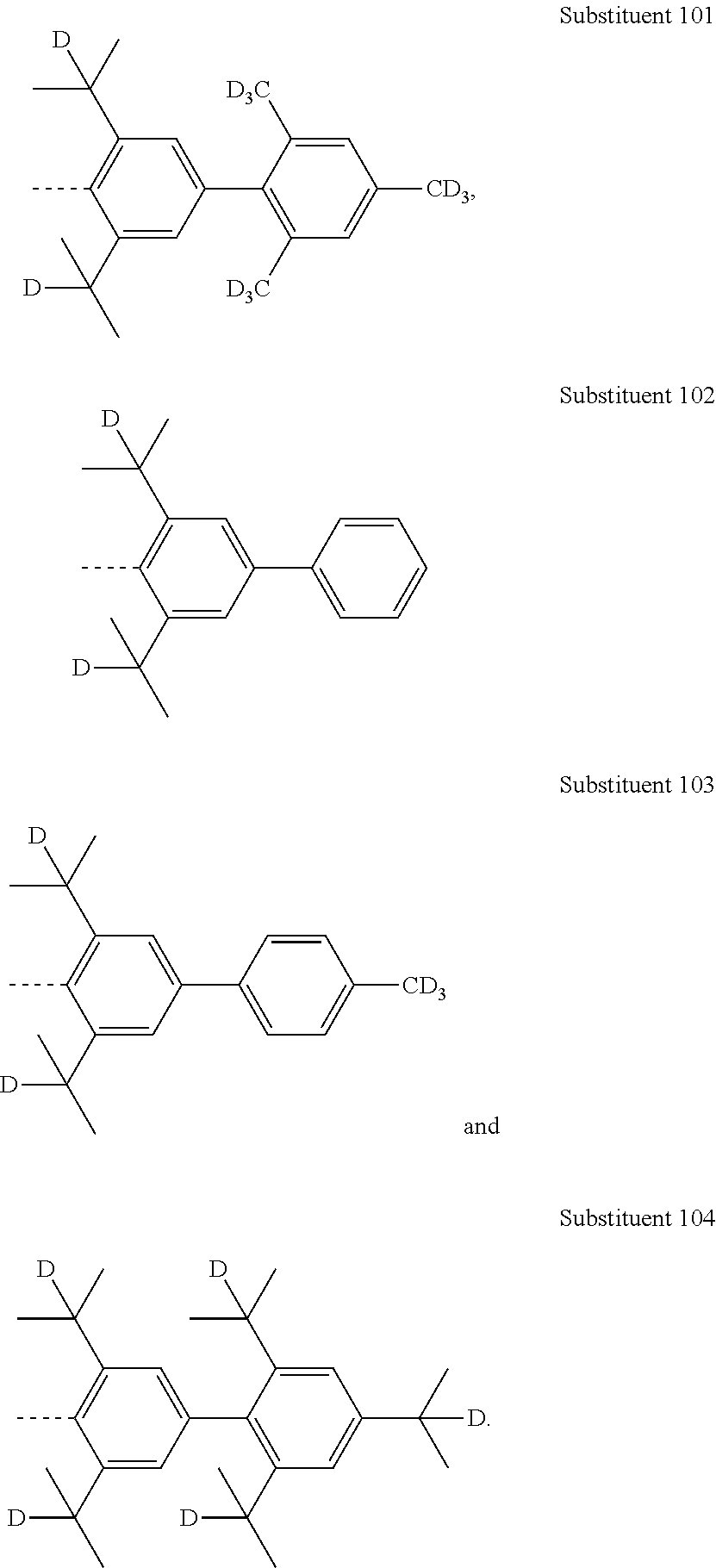
C00026

C00027

C00028

C00029

C00030

C00031
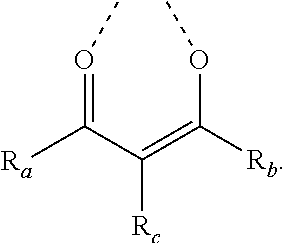
C00032

C00033

C00034

C00035

C00036

C00037

C00038

C00039

C00040
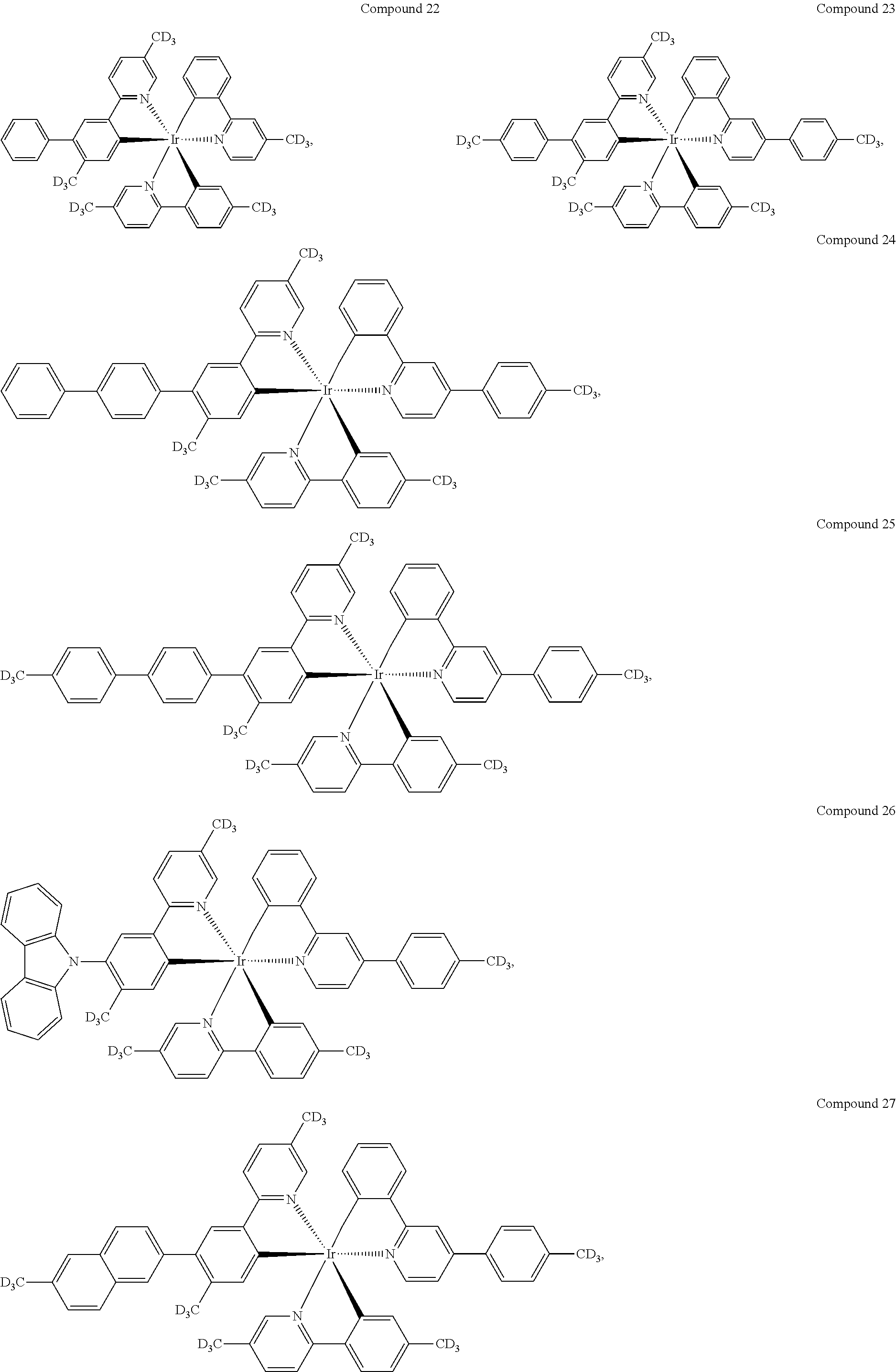
C00041

C00042
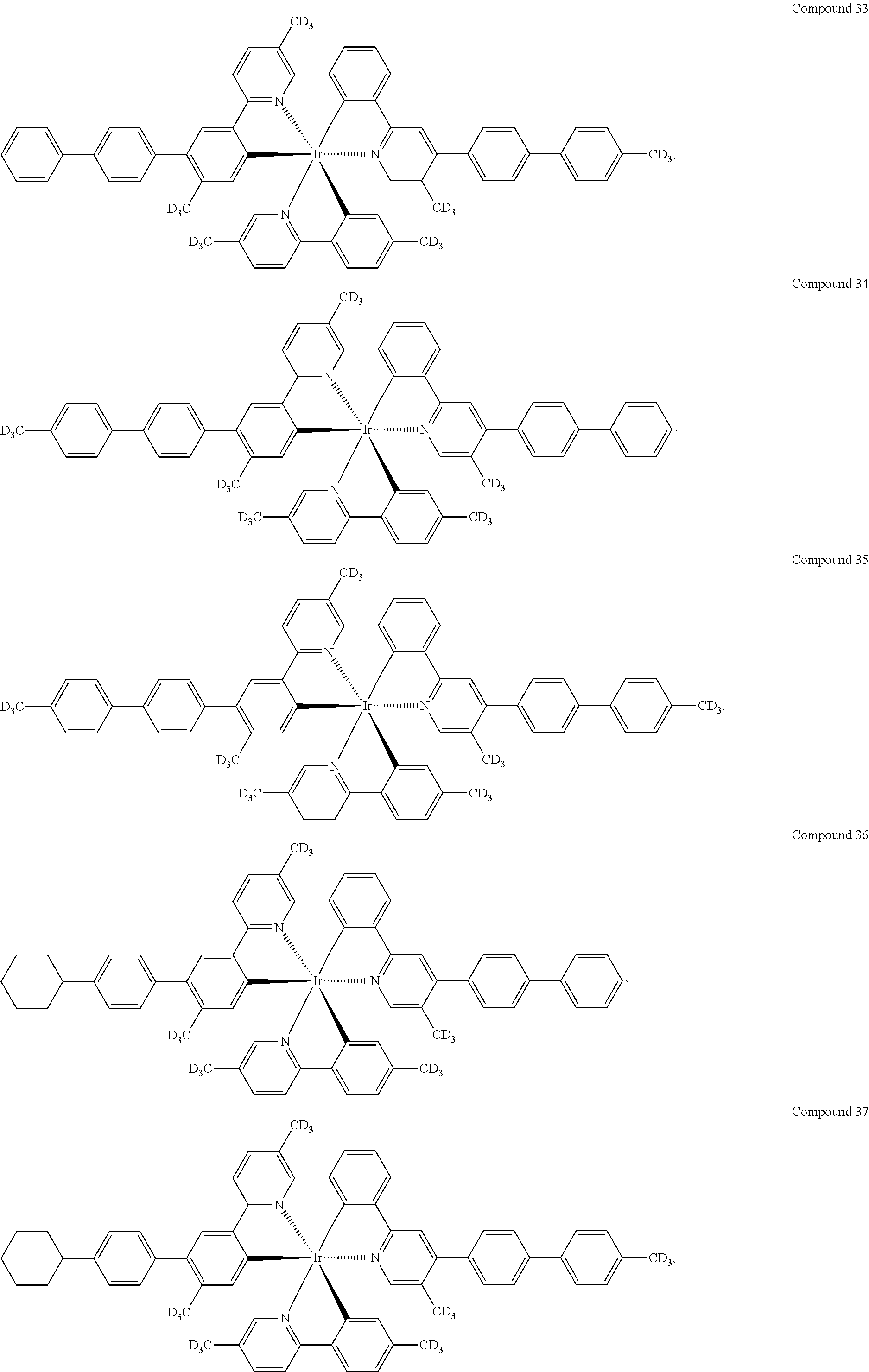
C00043

C00044

C00045
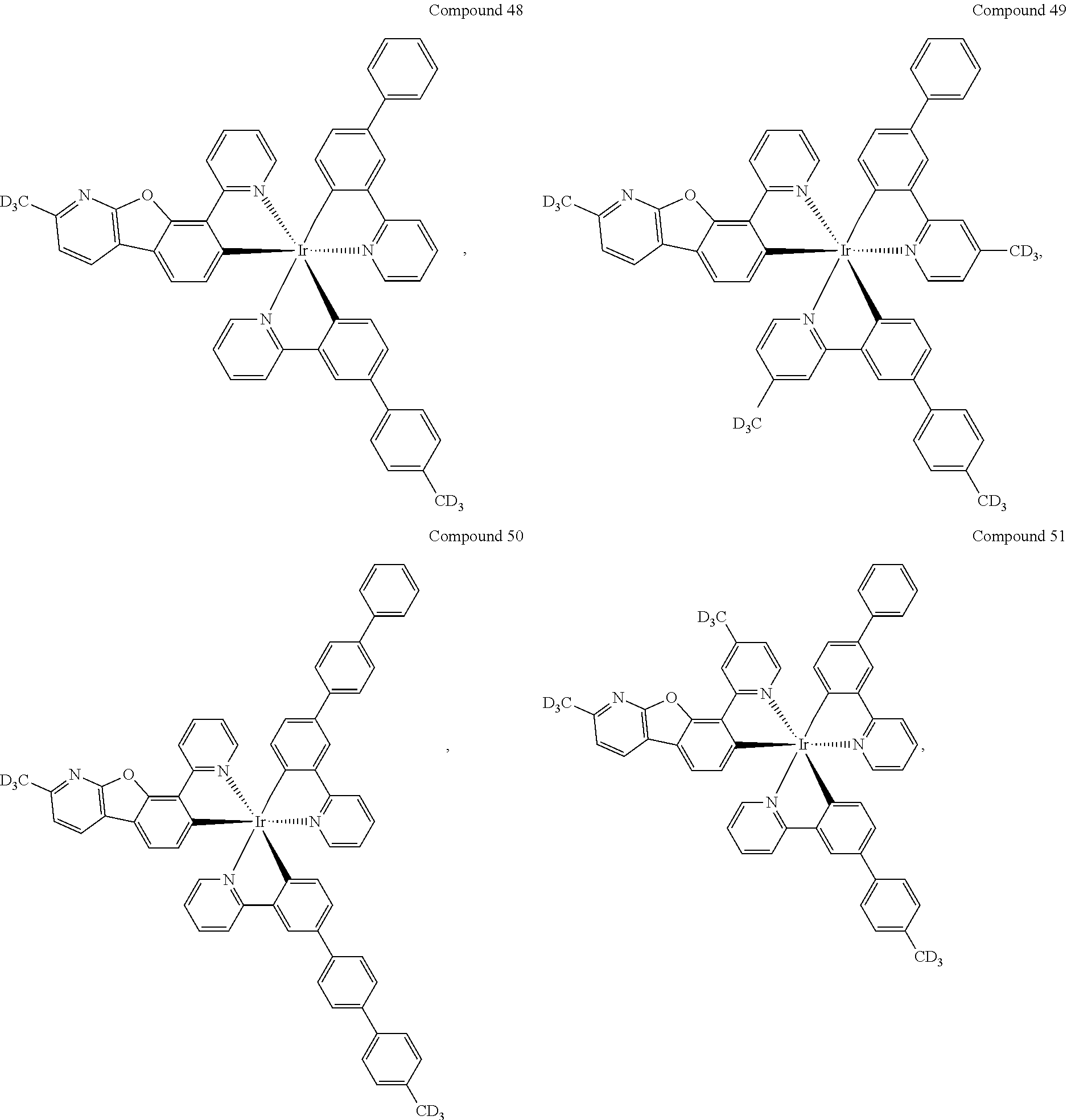
C00046

C00047

C00048

C00049

C00050

C00051

C00052

C00053

C00054
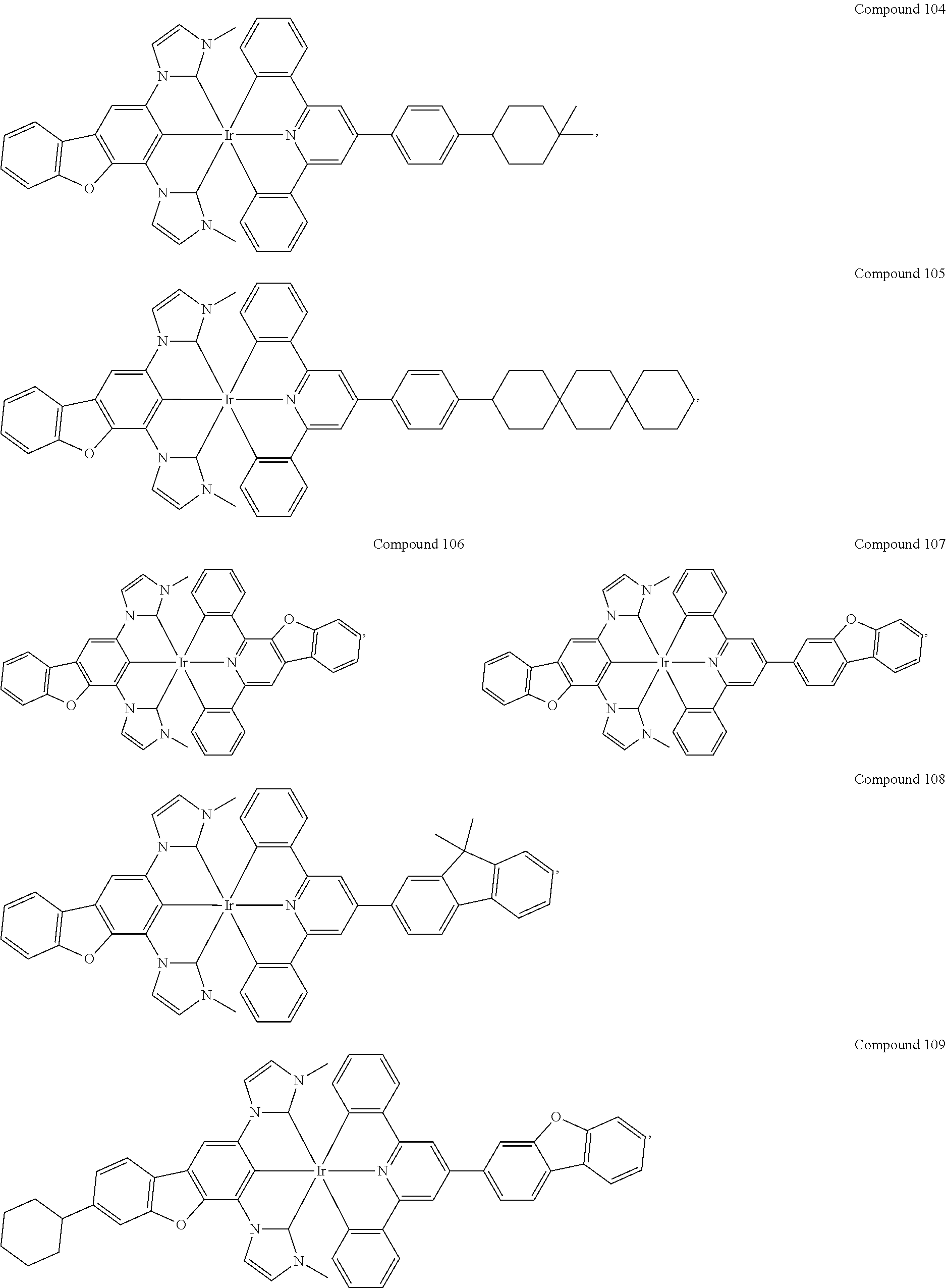
C00055

C00056

C00057
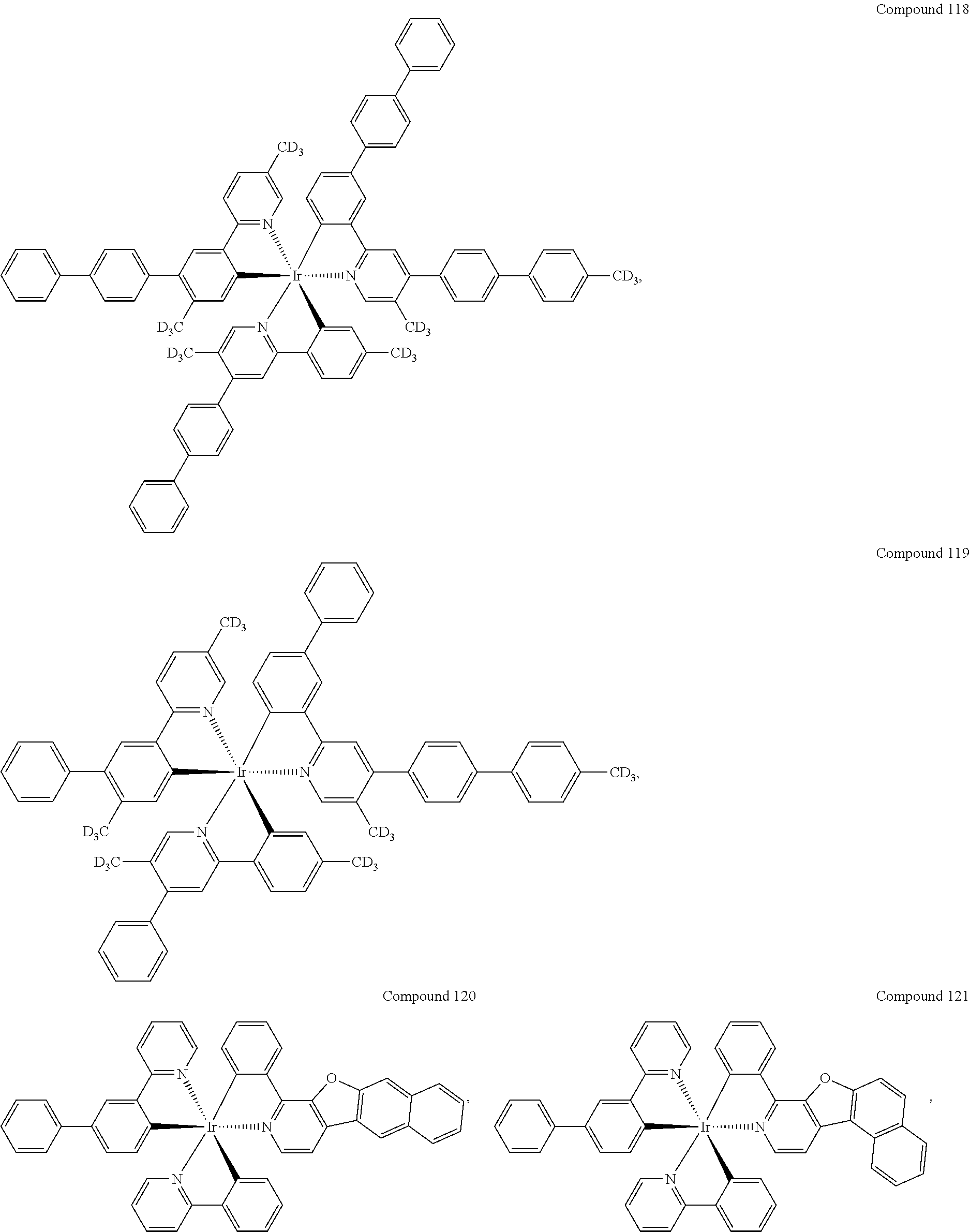
C00058
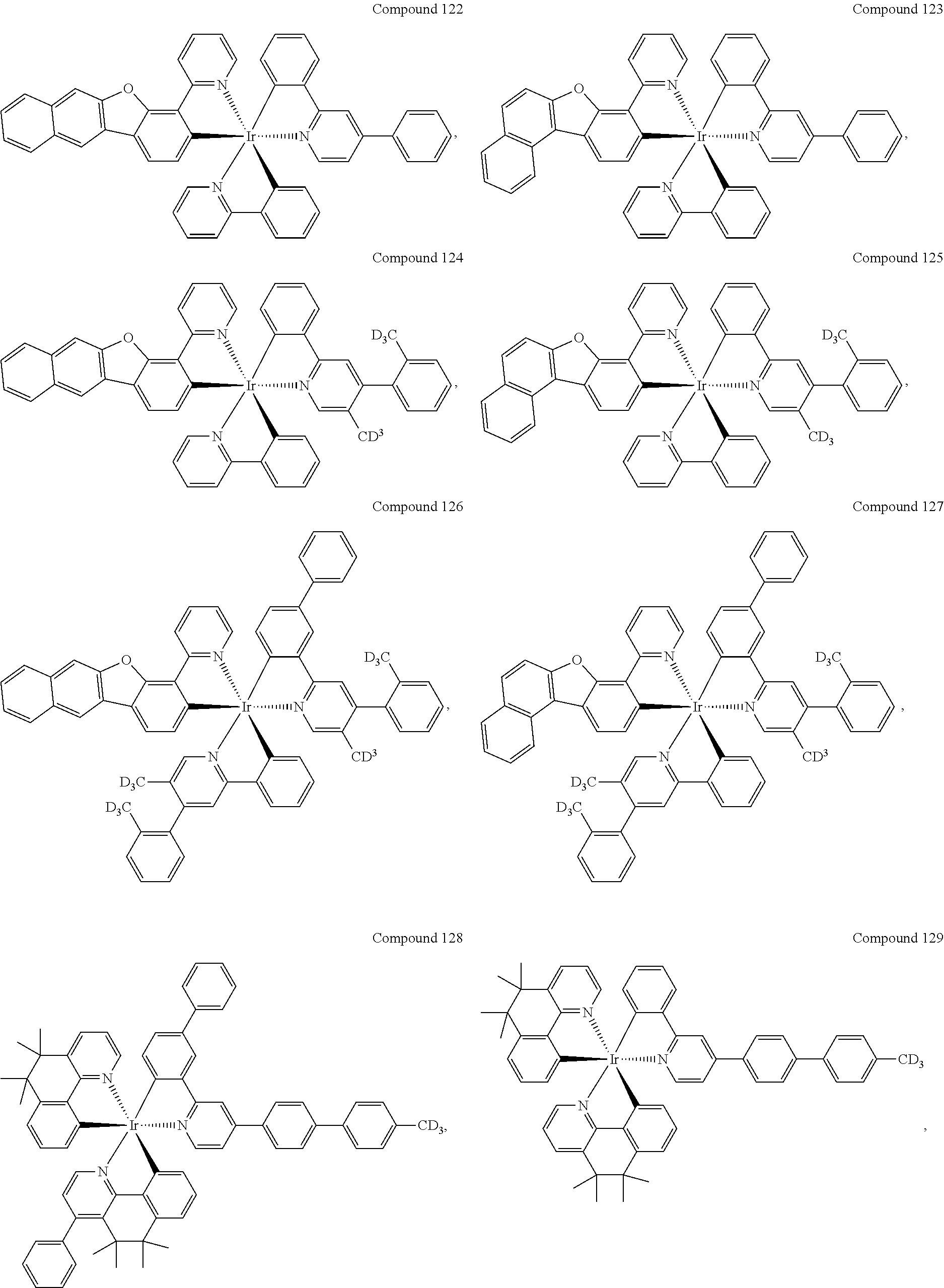
C00059

C00060

C00061

C00062

C00063

C00064

C00065

C00066

C00067

C00068

C00069

C00070

C00071
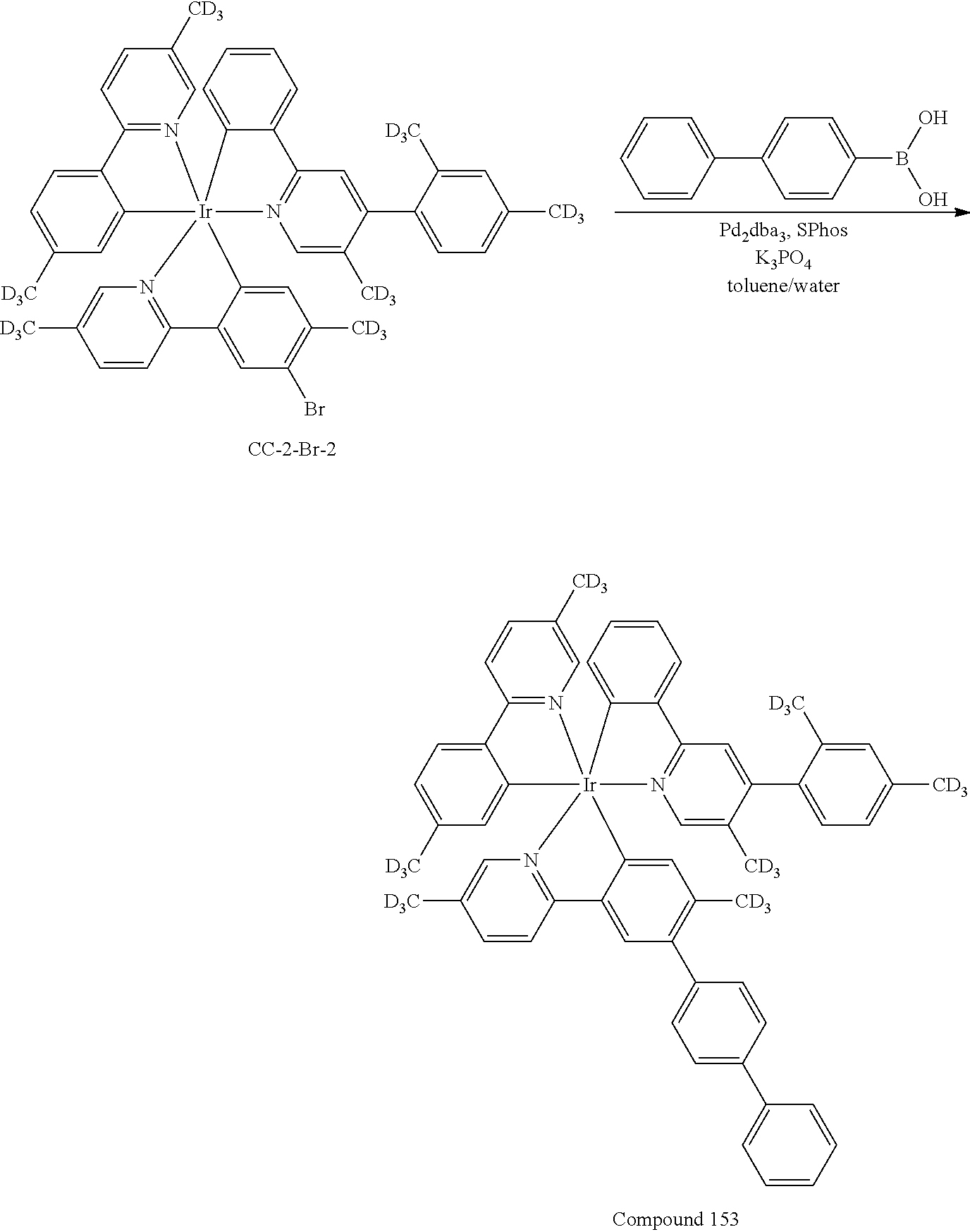
C00072
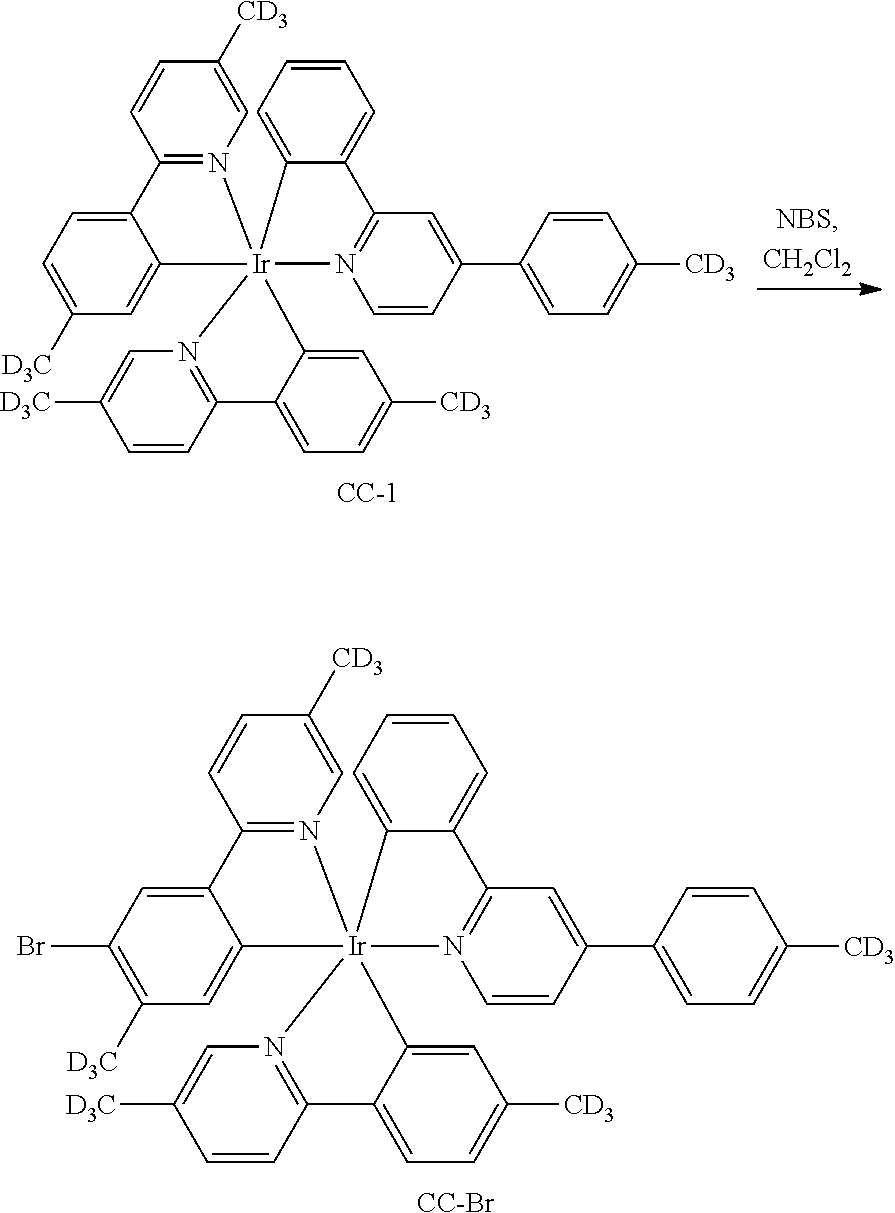
C00073

C00074

C00075

C00076

C00077

C00078

C00079

C00080

C00081

C00082

C00083

C00084

C00085

C00086

C00087

C00088

C00089

C00090

C00091

C00092

C00093

C00094

C00095

C00096
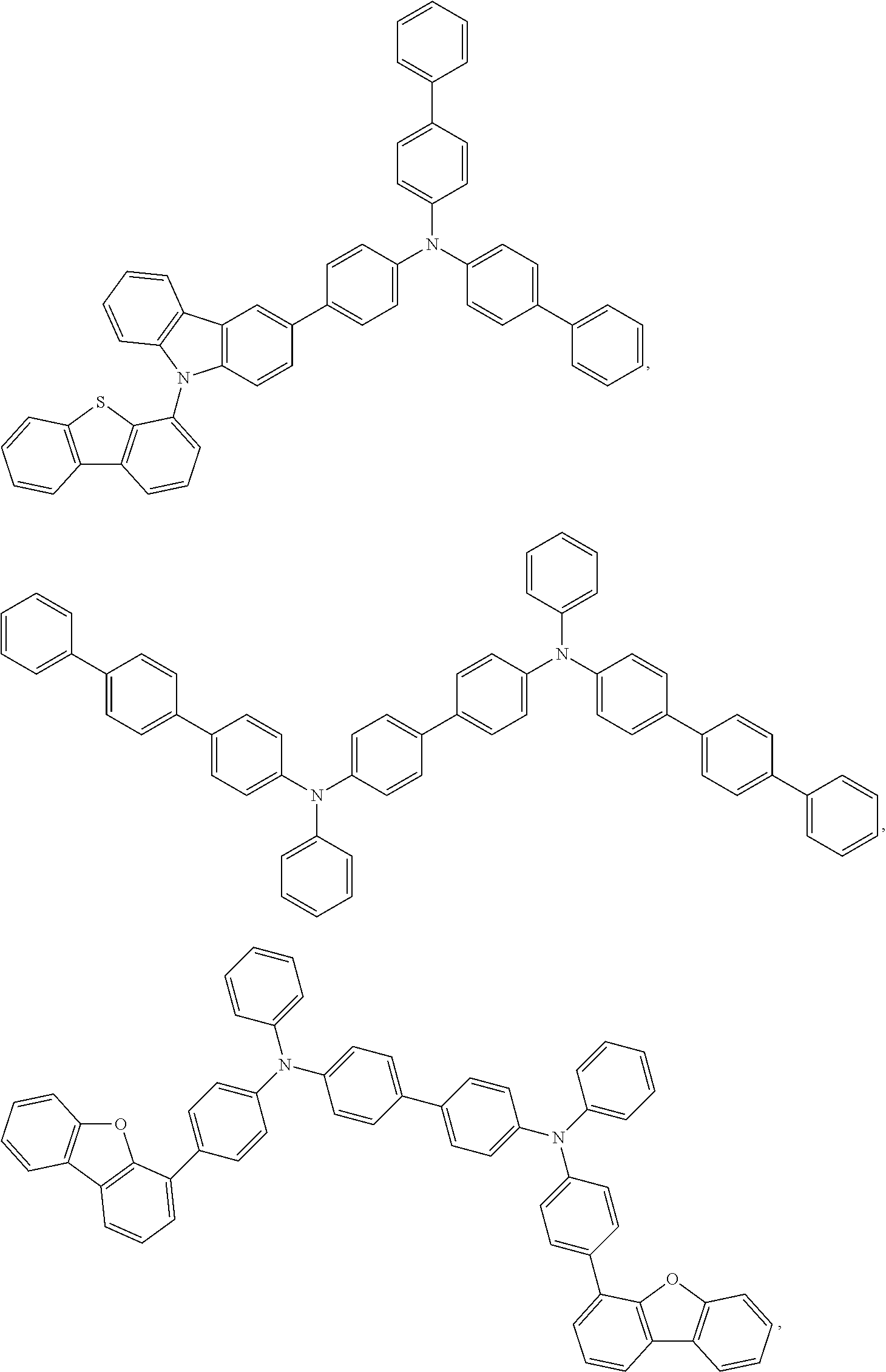
C00097
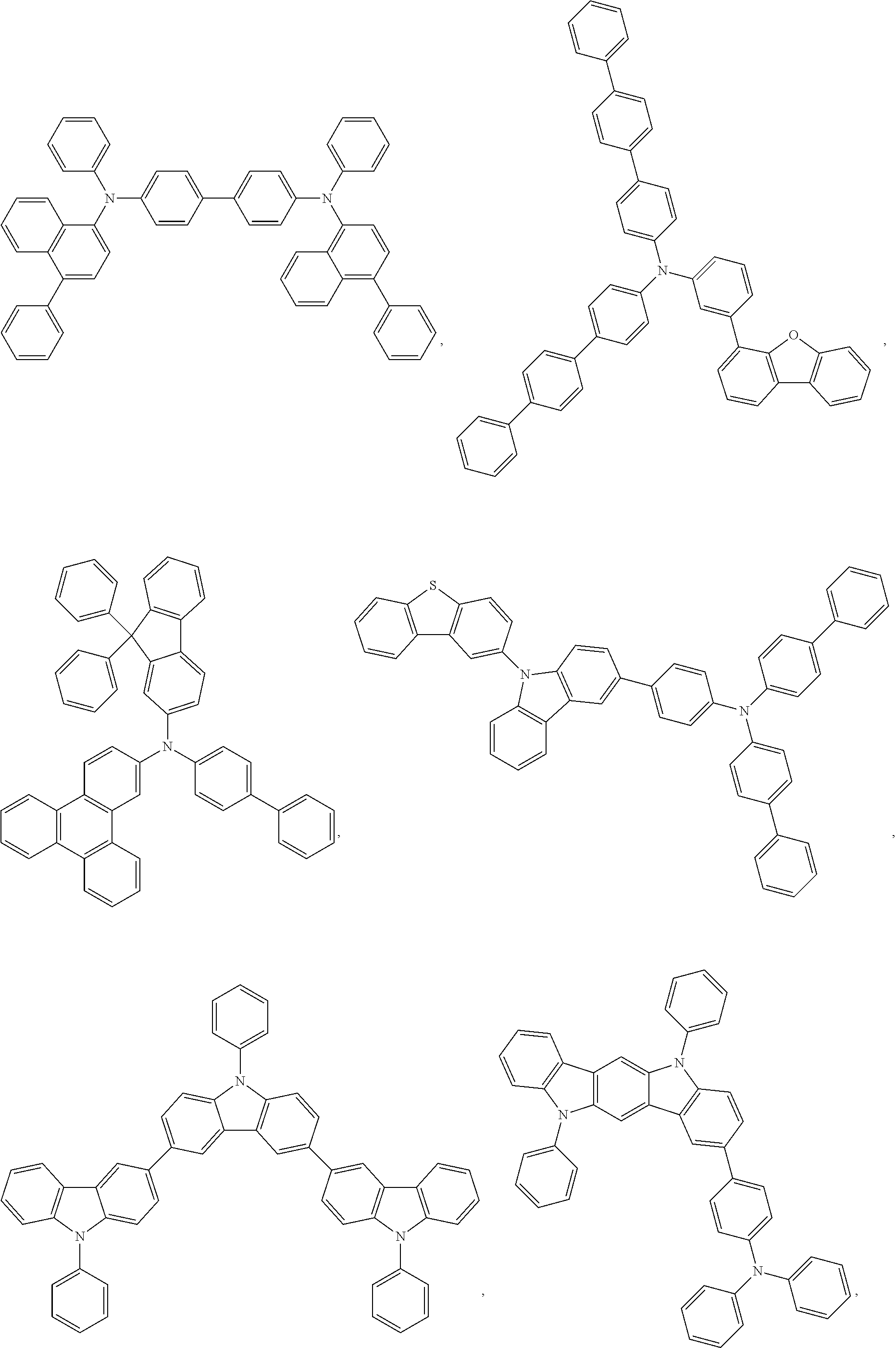
C00098

C00099
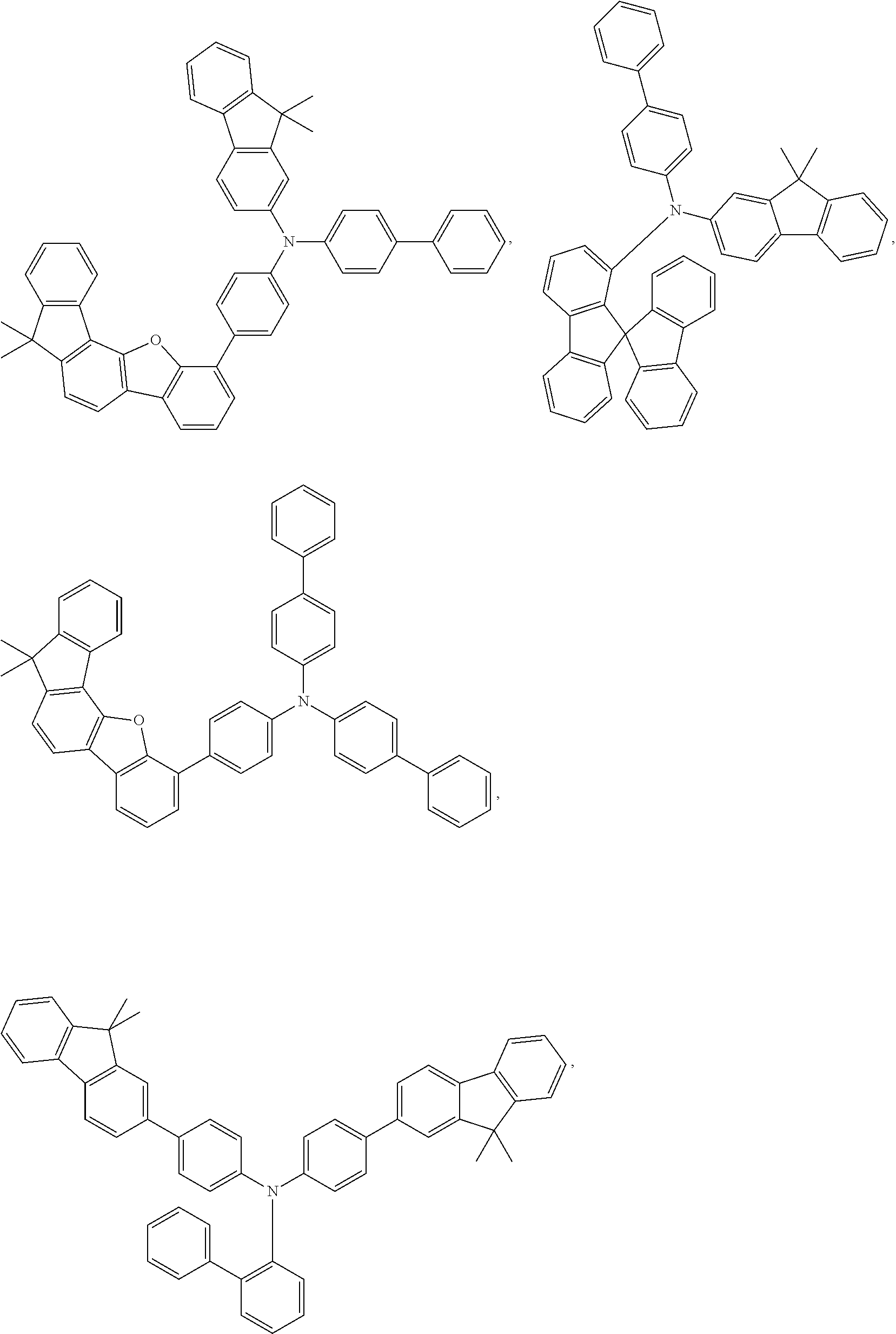
C00100

C00101

C00102

C00103

C00104

C00105

C00106

C00107

C00108
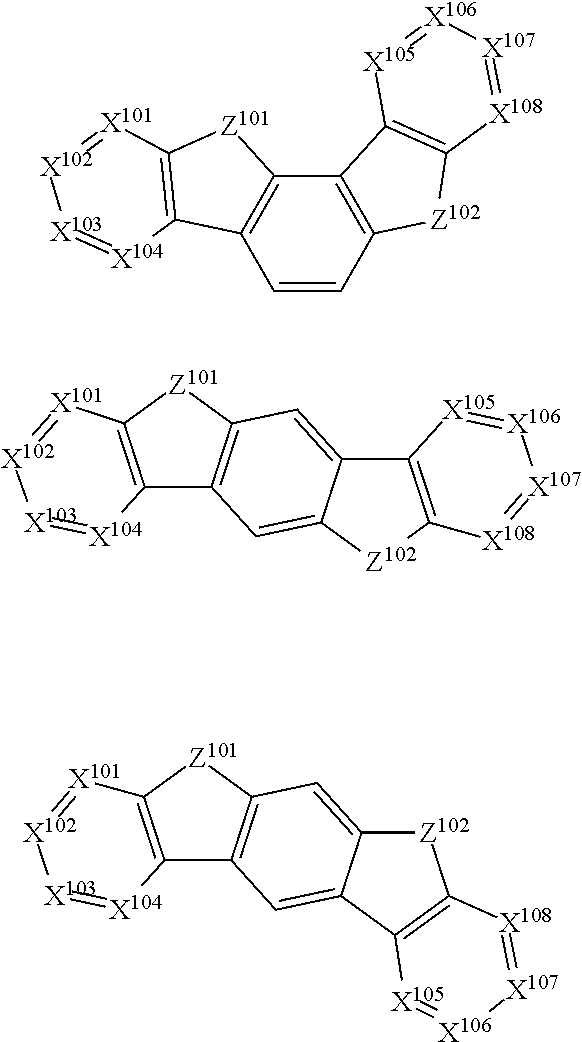
C00109

C00110

C00111

C00112

C00113

C00114
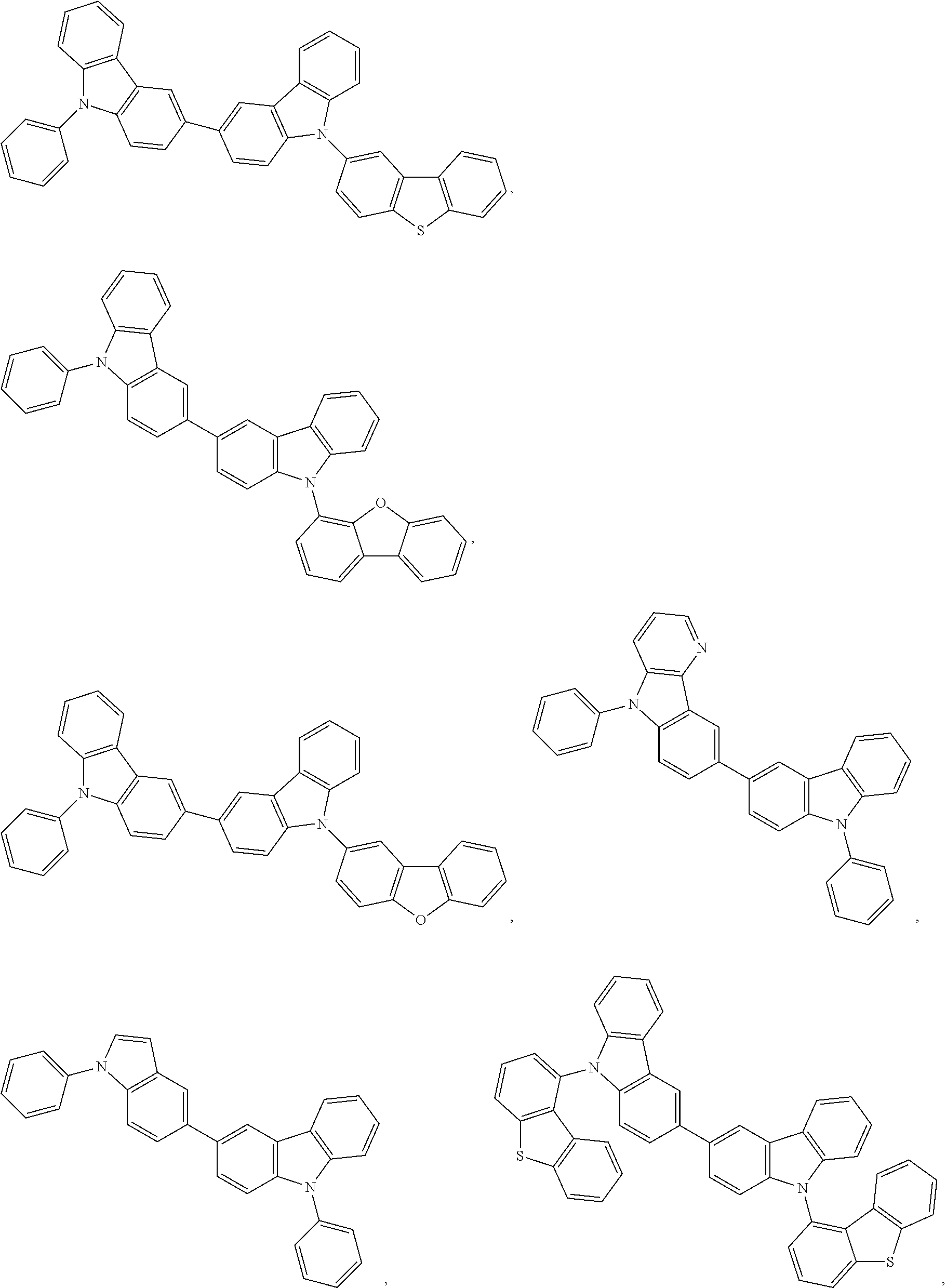
C00115
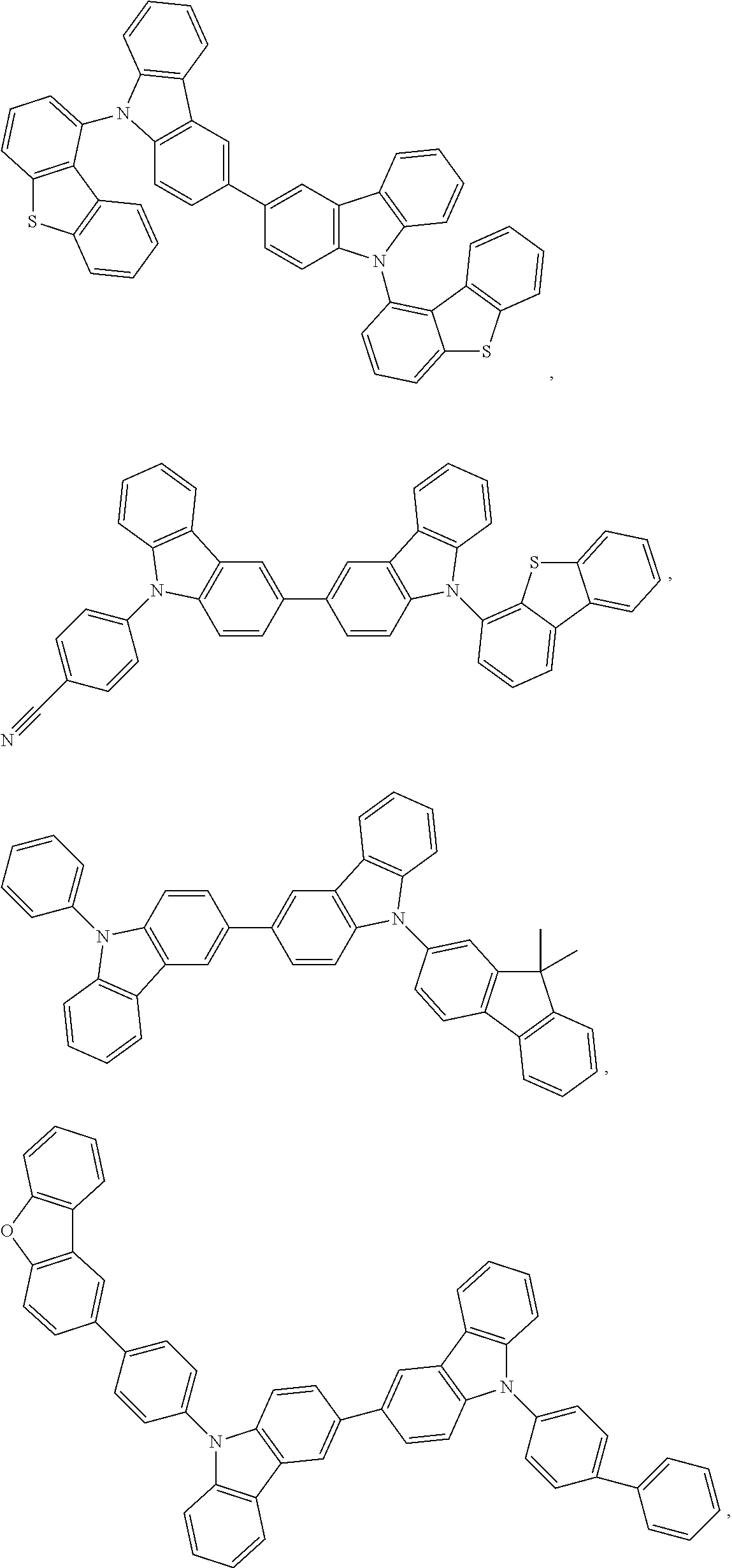
C00116

C00117

C00118

C00119

C00120

C00121

C00122

C00123

C00124

C00125

C00126

C00127
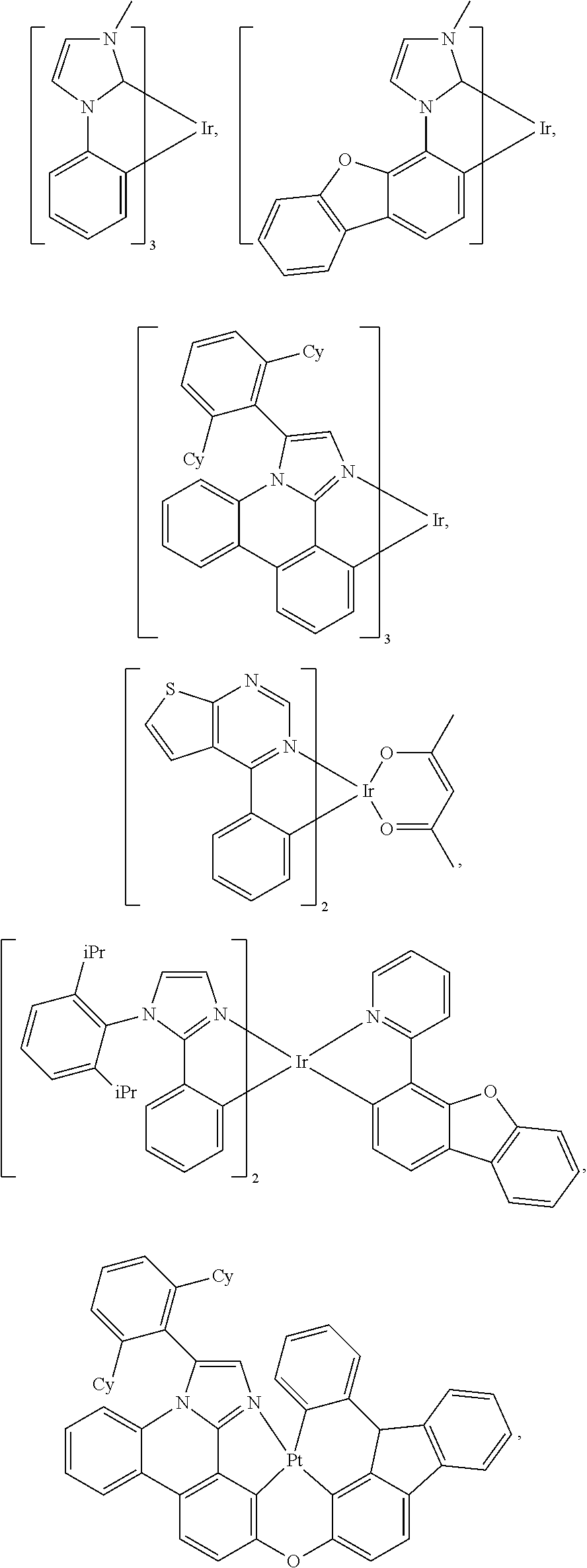
C00128
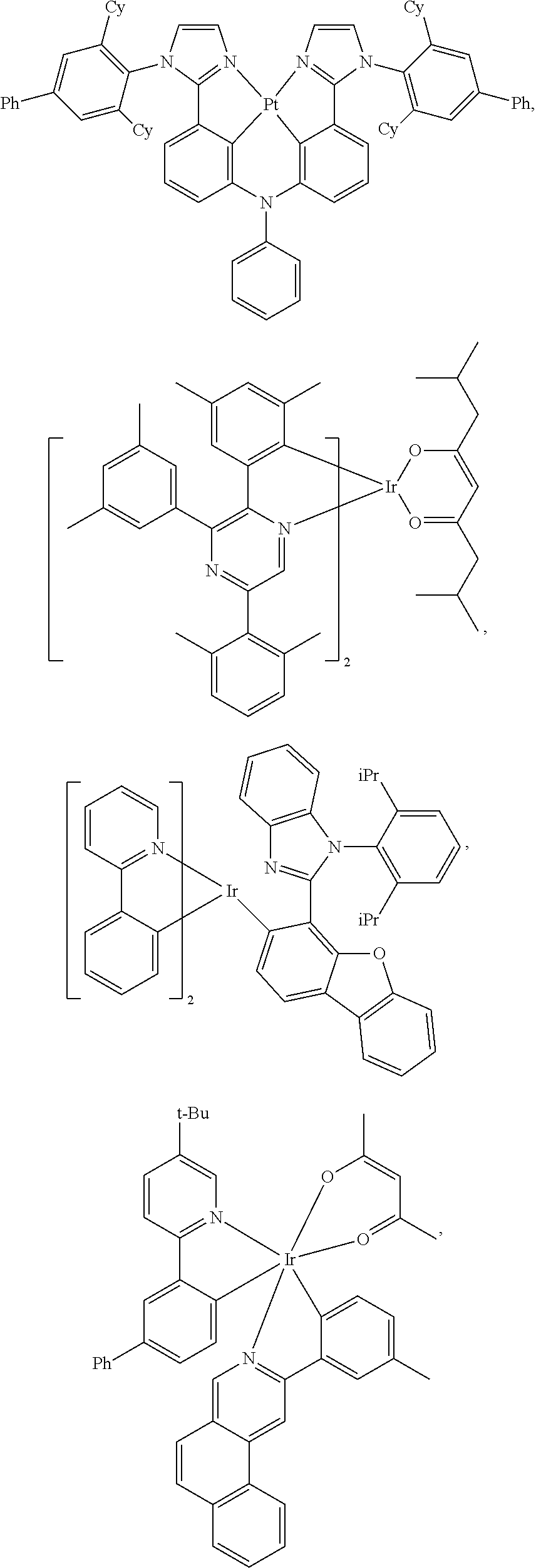
C00129

C00130

C00131

C00132

C00133

C00134

C00135

C00136

C00137

C00138

C00139

C00140

C00141

C00142

C00143

C00144
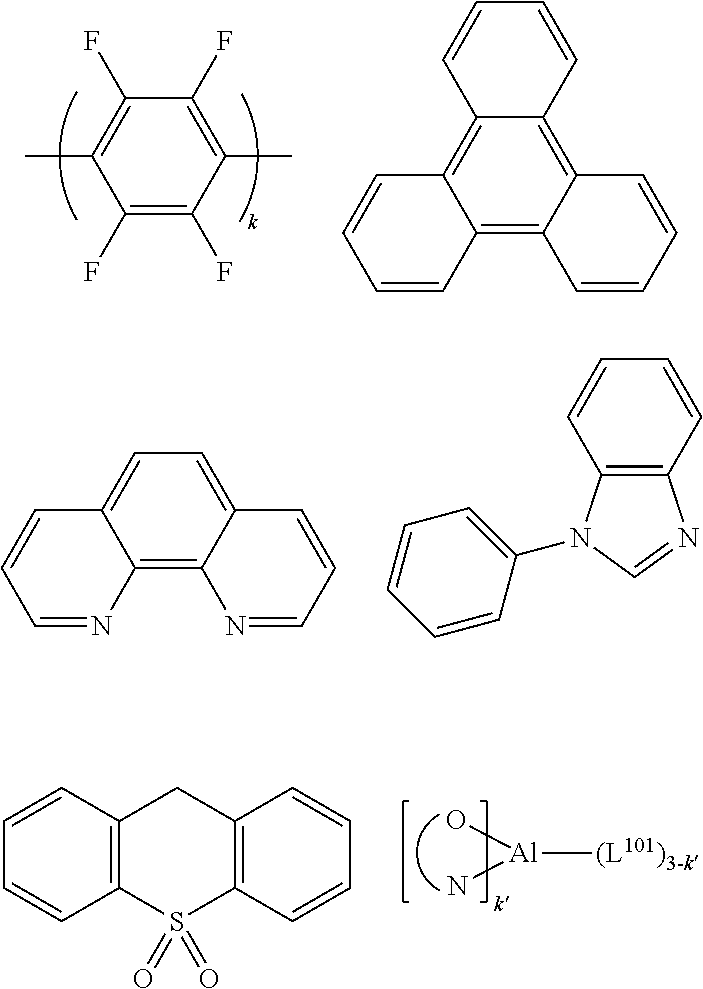
C00145
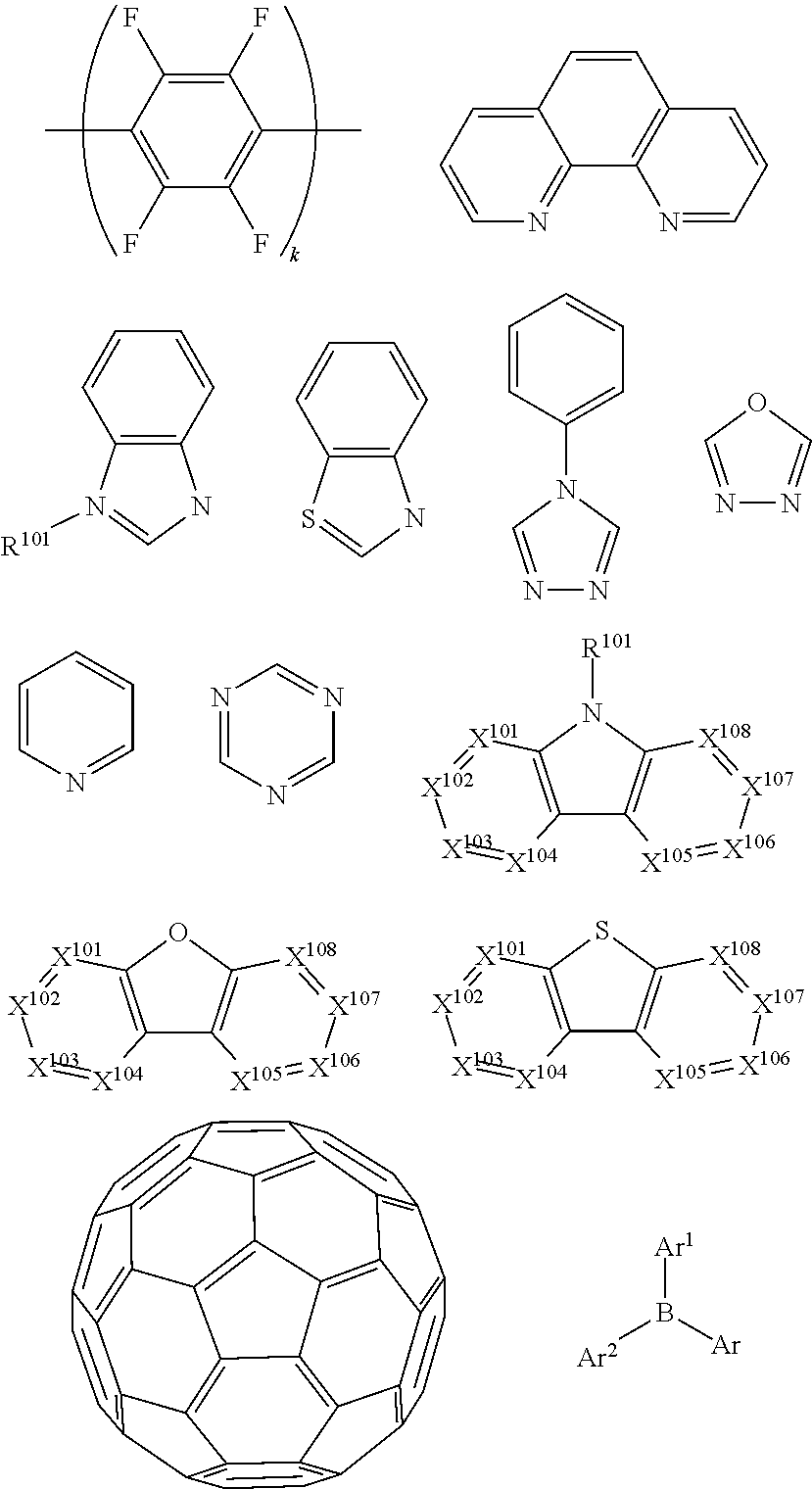
C00146

C00147

C00148

C00149

C00150

C00151

C00152
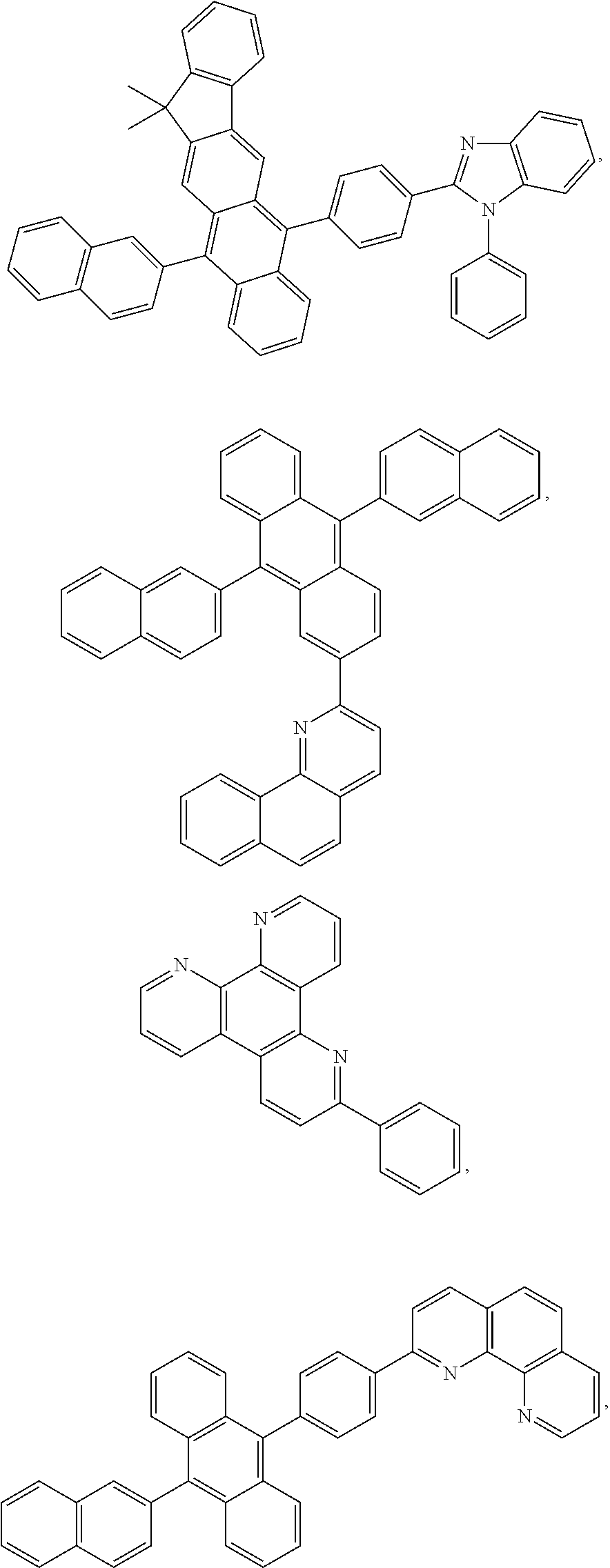
C00153

C00154

C00155

C00156
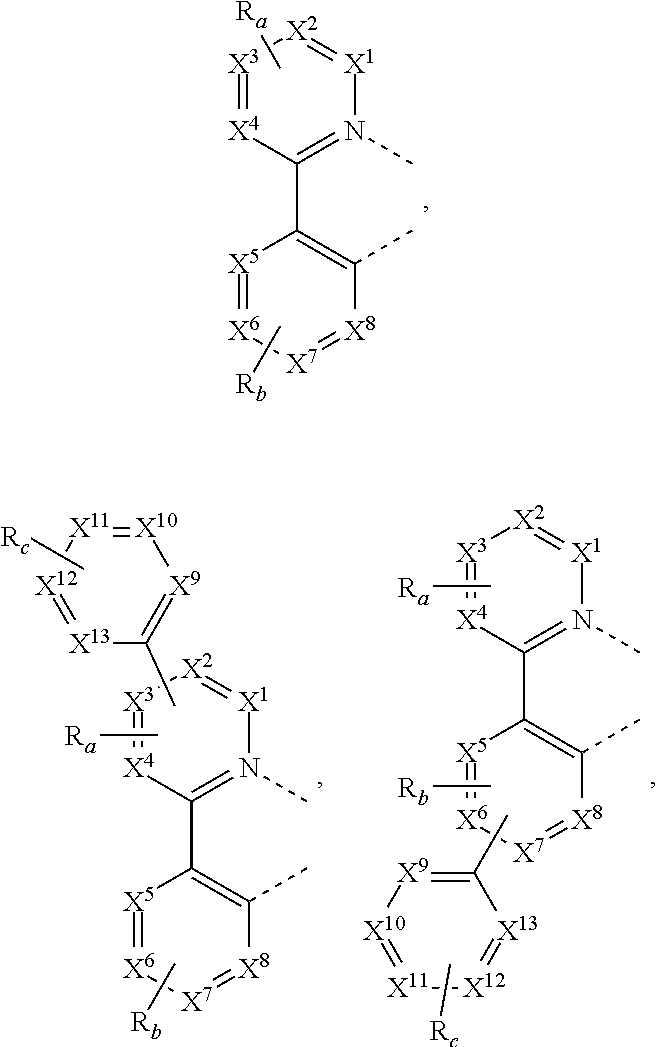
C00157

C00158

C00159

C00160

C00161

C00162

C00163

C00164

C00165

C00166

C00167
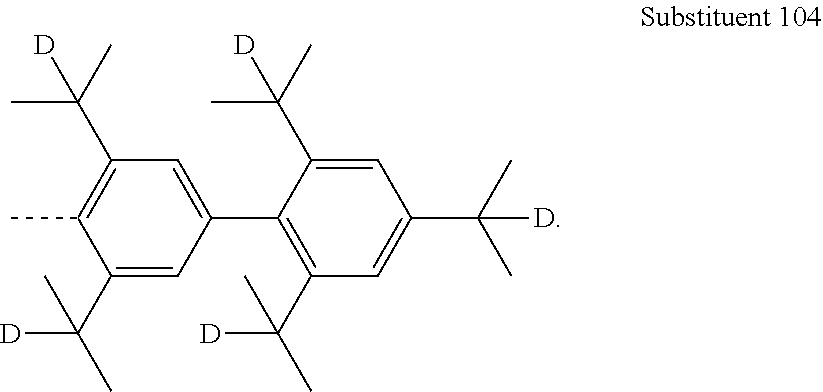
C00168

C00169
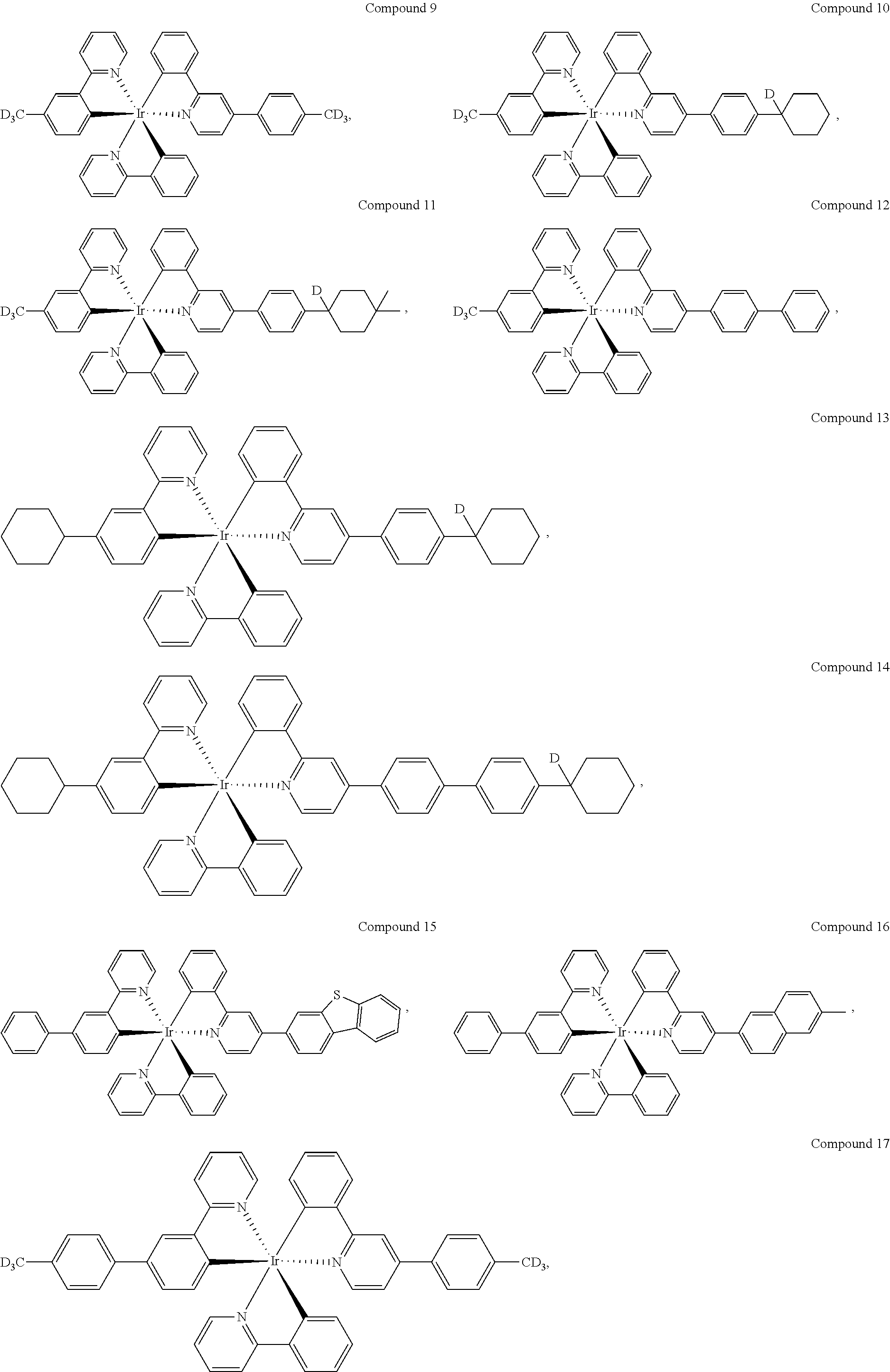
C00170

C00171

C00172

C00173

C00174

C00175

C00176

C00177

C00178

C00179

C00180

C00181
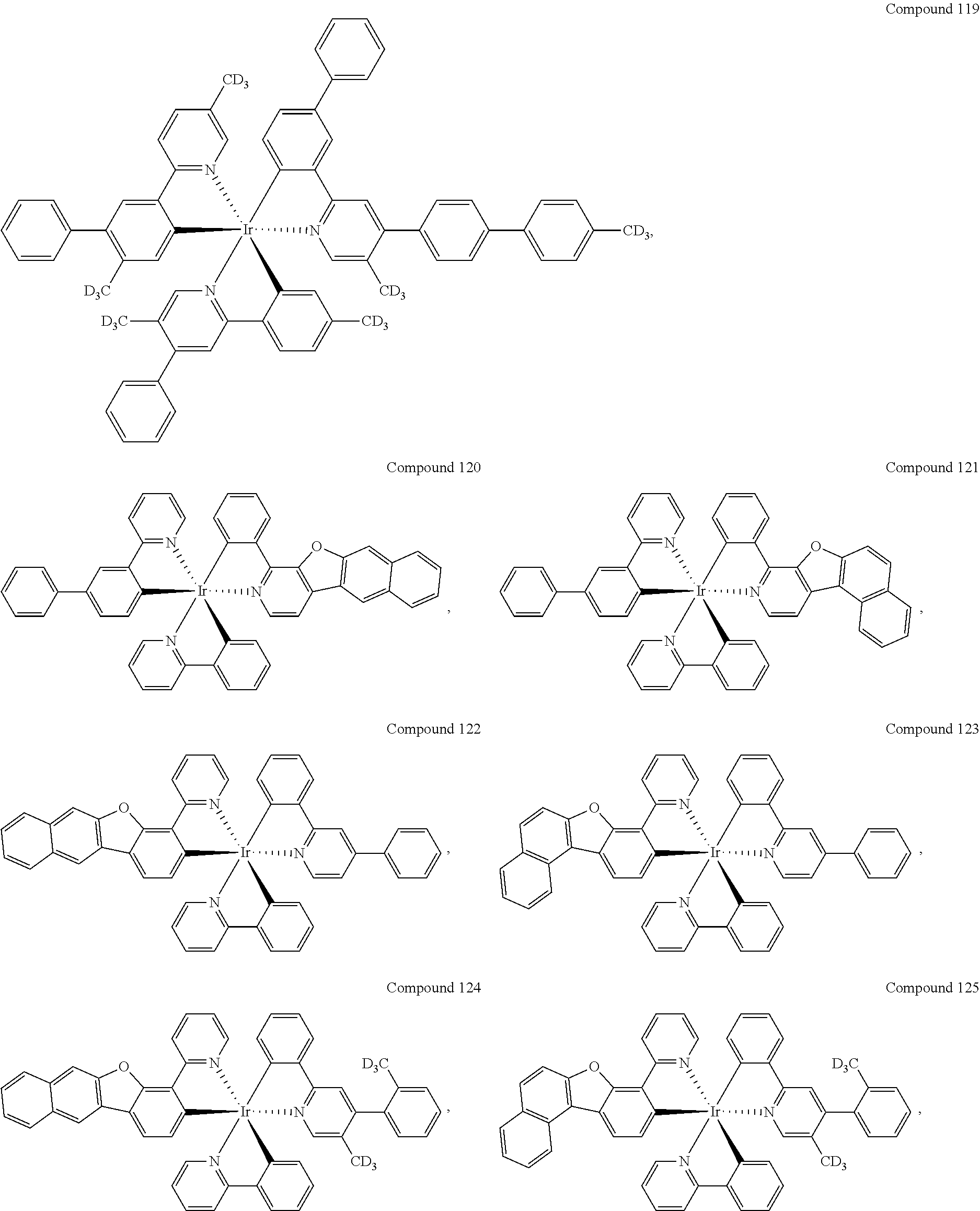
C00182
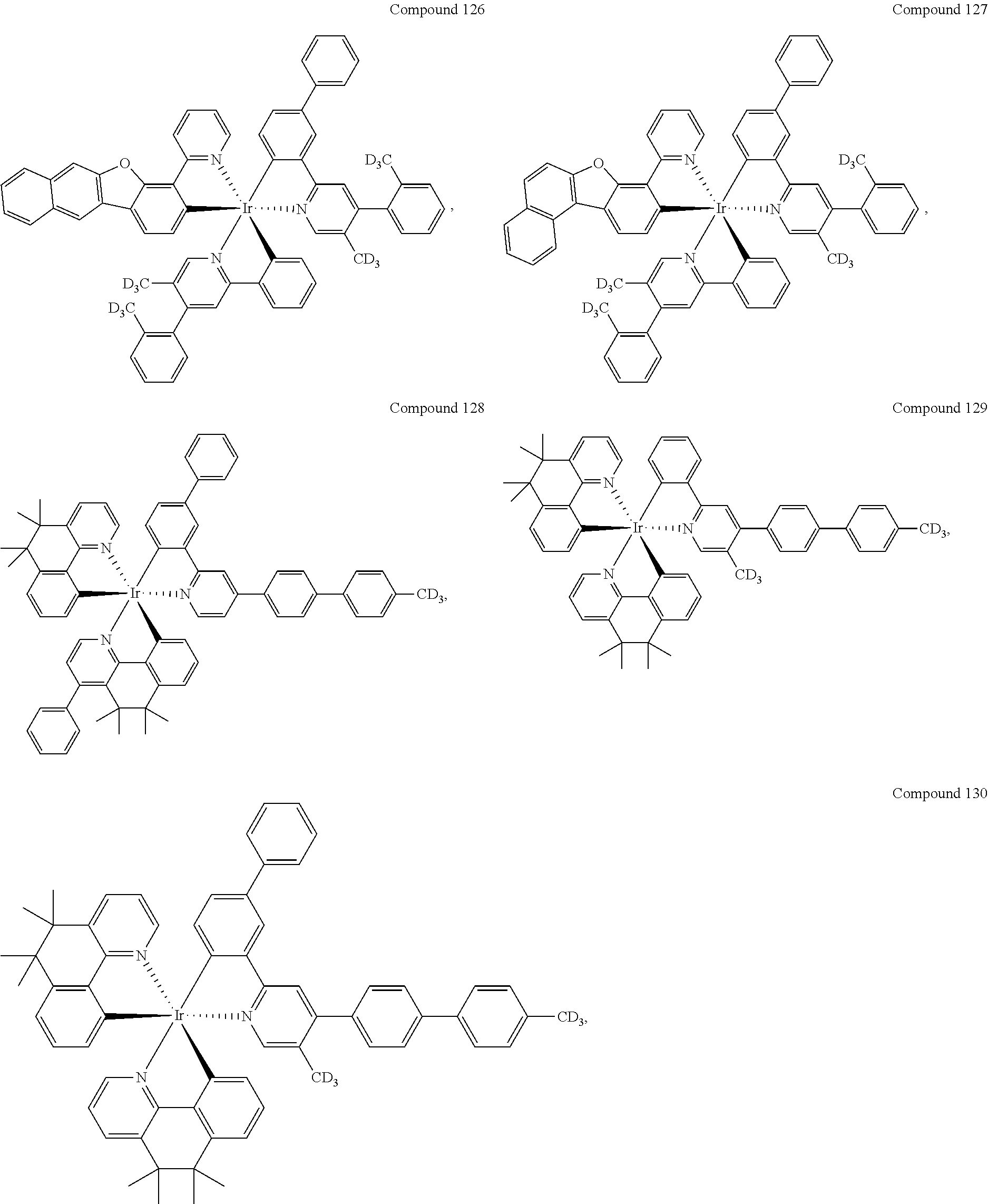
C00183
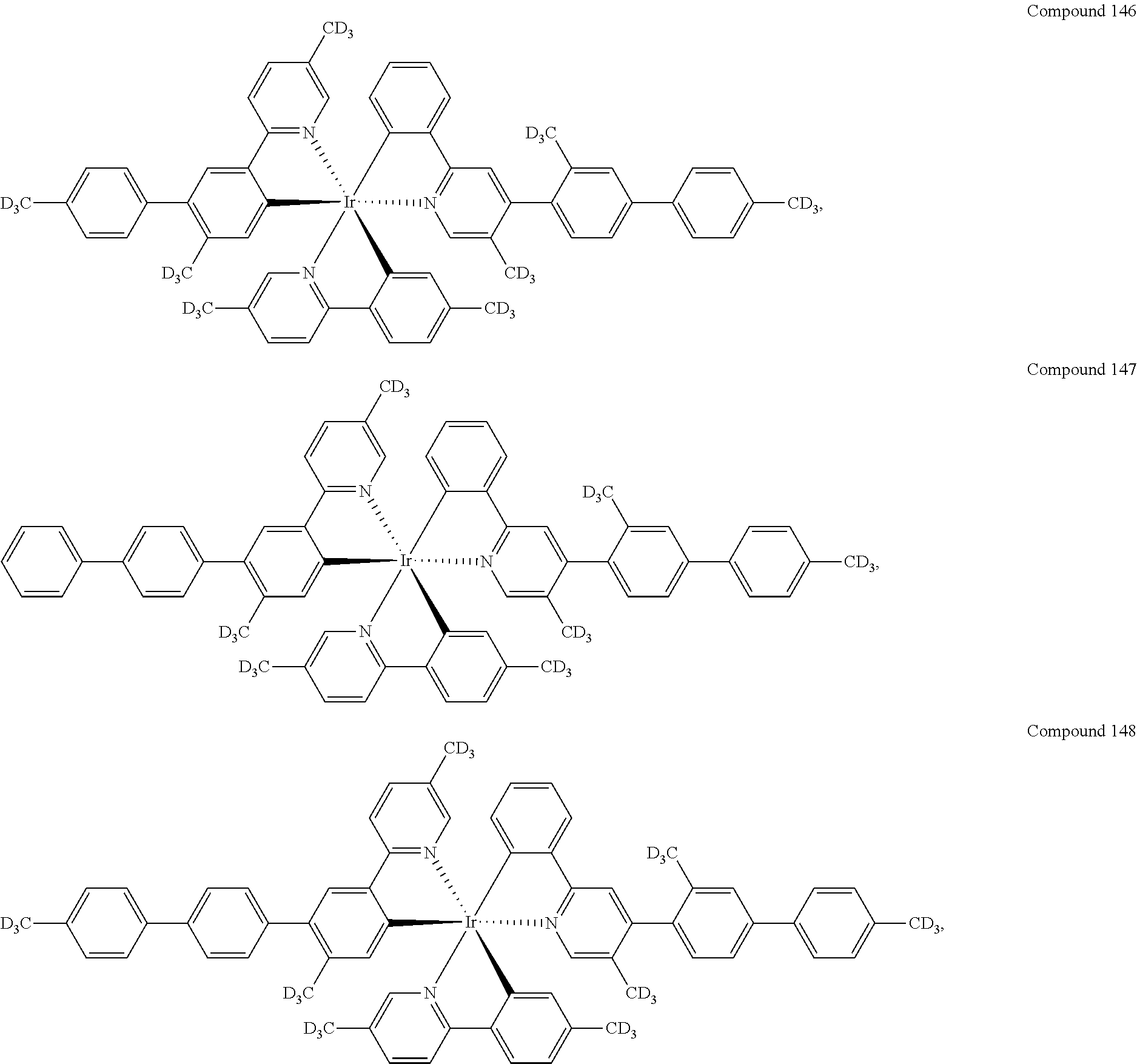
C00184

C00185

D00000
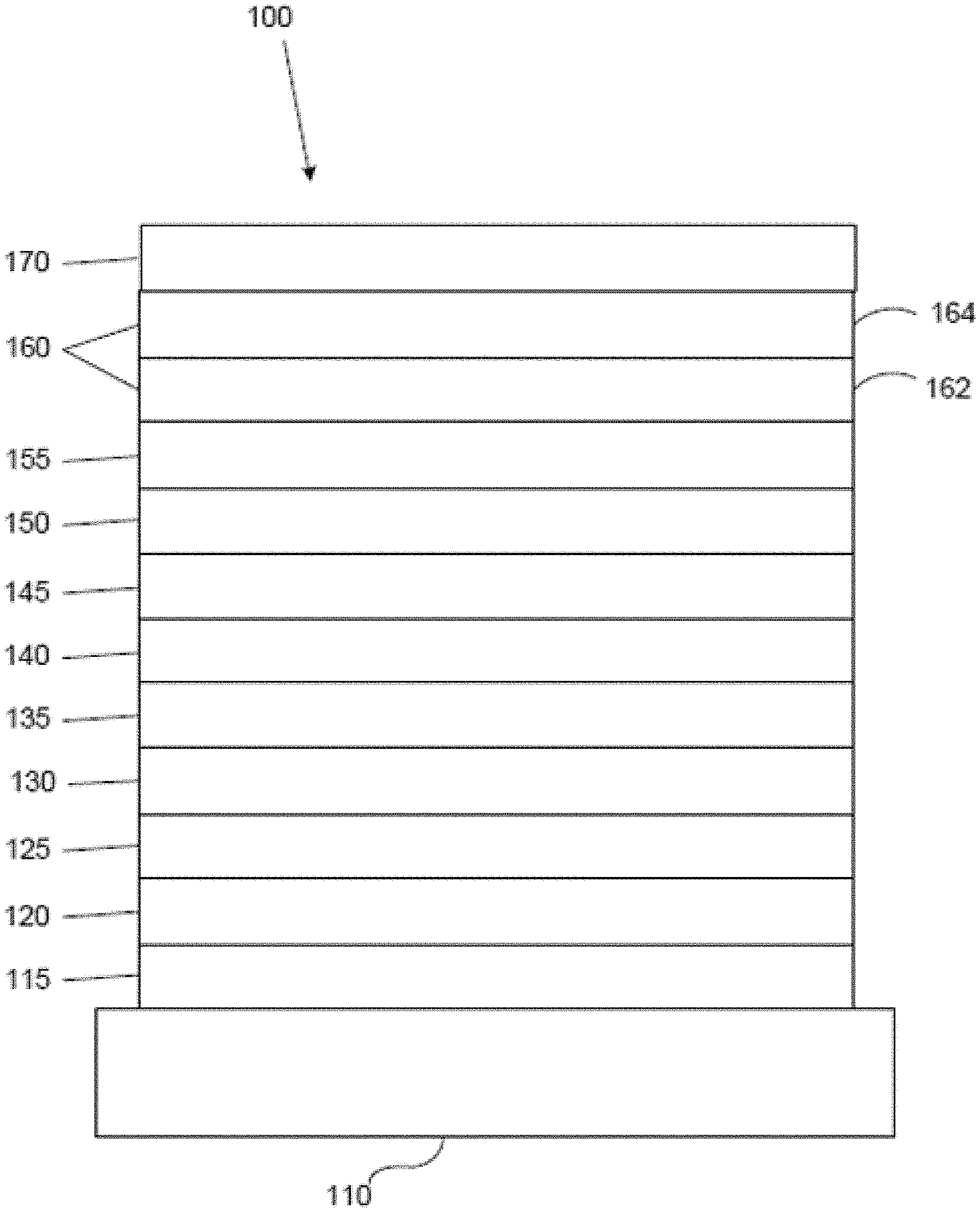
D00001
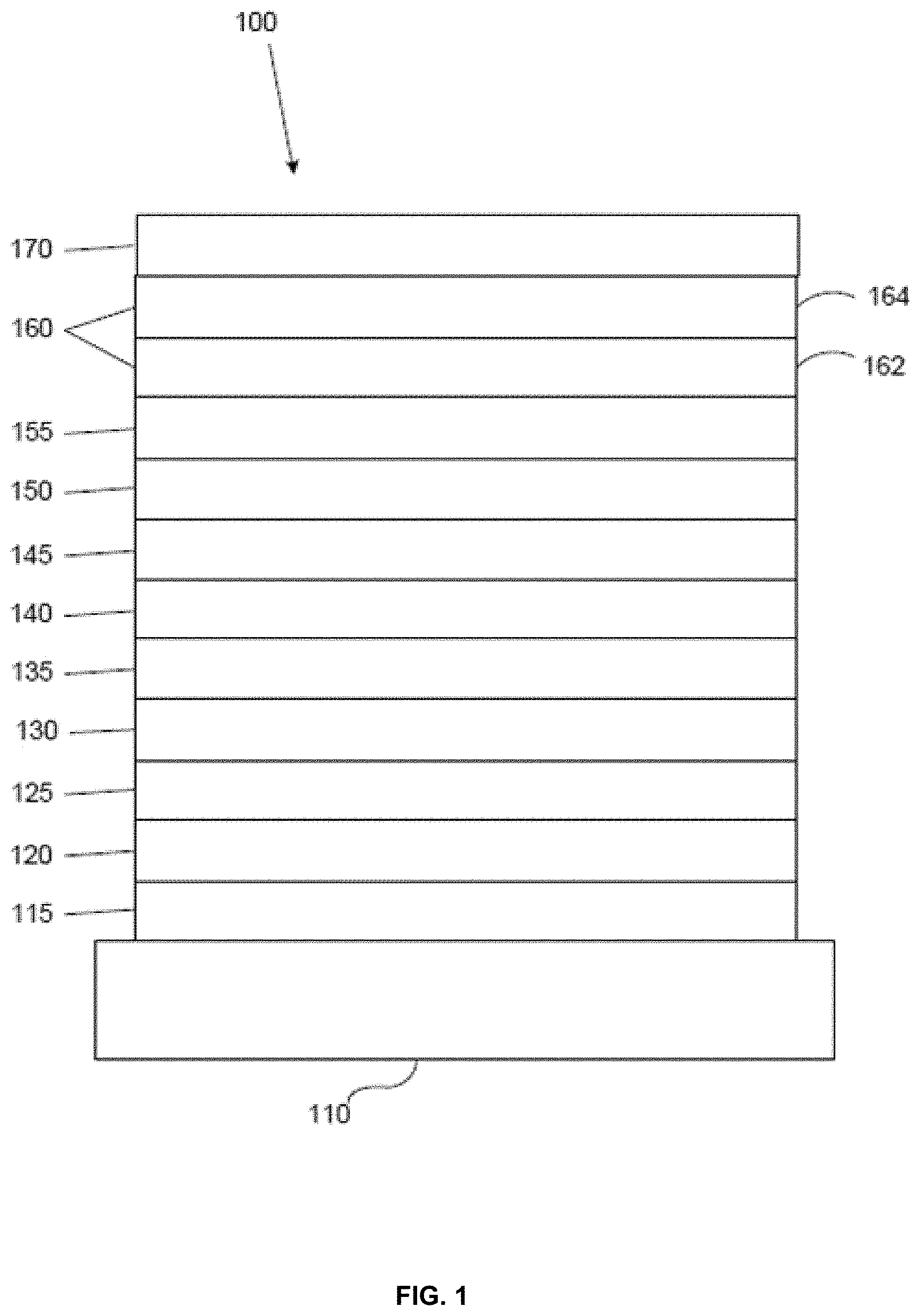
D00002

D00003

D00004

D00005

D00006

D00007

D00008

XML
uspto.report is an independent third-party trademark research tool that is not affiliated, endorsed, or sponsored by the United States Patent and Trademark Office (USPTO) or any other governmental organization. The information provided by uspto.report is based on publicly available data at the time of writing and is intended for informational purposes only.
While we strive to provide accurate and up-to-date information, we do not guarantee the accuracy, completeness, reliability, or suitability of the information displayed on this site. The use of this site is at your own risk. Any reliance you place on such information is therefore strictly at your own risk.
All official trademark data, including owner information, should be verified by visiting the official USPTO website at www.uspto.gov. This site is not intended to replace professional legal advice and should not be used as a substitute for consulting with a legal professional who is knowledgeable about trademark law.